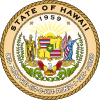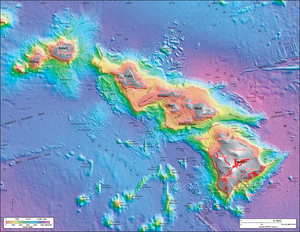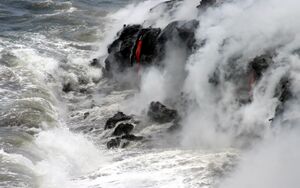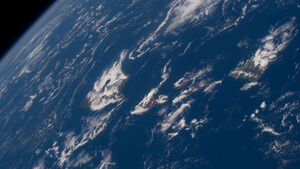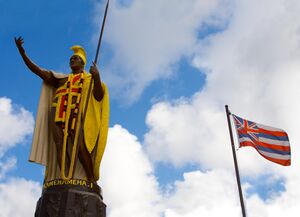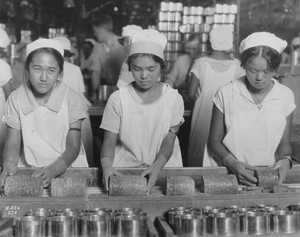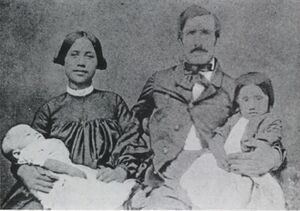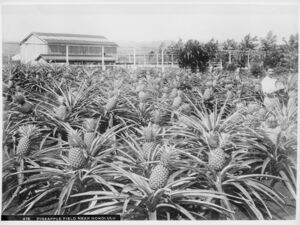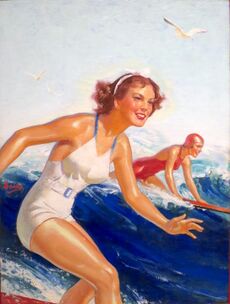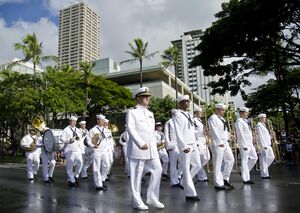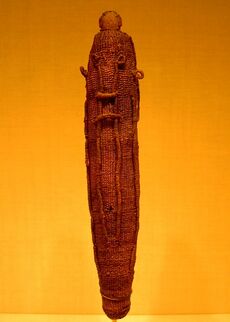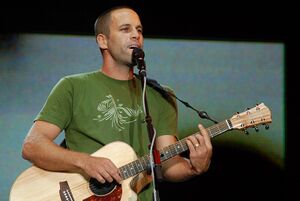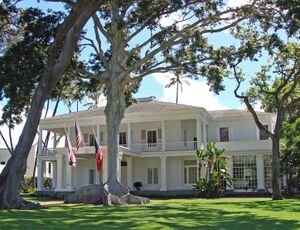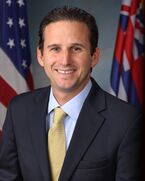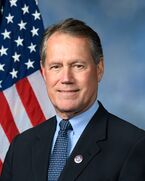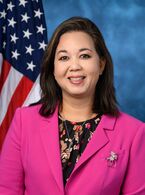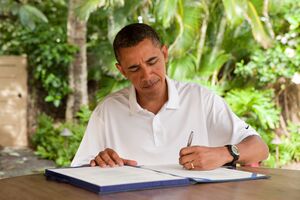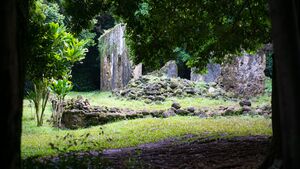هاواي
Hawaii
Hawaiʻi (Hawaiian) | |
|---|---|
| State of Hawaii Mokuʻāina o Hawaiʻi (Hawaiian) | |
| الكنية: | |
| الشعار: | |
| النشيد: Hawaiʻi Ponoʻī (Hawaiʻi's Own True Sons)[4] | |
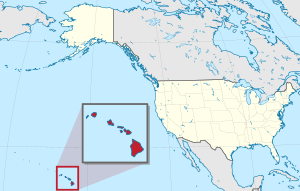 خريطة الولايات المتحدة، موضح فيها Hawaii | |
| البلد | الولايات المتحدة |
| قبل الولائية | Territory of Hawaii |
| انضمت للاتحاد | أغسطس 21, 1959 (50) |
| العاصمة (وأكبر مدينة) | Honolulu |
| أكبر منطقة عمرانية | Honolulu |
| الحكومة | |
| • الحاكم | Josh Green (D) |
| • نائب الحاكم | Sylvia Luke (D) |
| المجلس التشريعي | State Legislature |
| • المجلس العلوي | Senate |
| • المجلس السفلى | House of Representatives |
| القضاء | Supreme Court of Hawaii |
| سناتورات الولايات المتحدة |
|
| وفد مجلس النواب | 1: Ed Case (D) 2: Jill Tokuda (D) (القائمة) |
| المساحة | |
| • الإجمالي | 10٬931 ميل² (28٬311 كم²) |
| • البر | 6٬423 ميل² (16٬638 كم²) |
| • الماء | 4٬507 ميل² (11٬672 كم²) 41.2% |
| ترتيب المساحة | 43rd |
| الأبعاد | |
| • الطول | 1٬522 mi (2٬450 km) |
| • العرض | n/a mi (n/a km) |
| المنسوب | 3٬030 ft (920 m) |
| أعلى منسوب | 13٬796 ft (4٬205٫0 m) |
| أوطى منسوب (Pacific Ocean[6]) | 0 ft (0 m) |
| التعداد (2020) | |
| • الإجمالي | 1٬455٬271 |
| • الترتيب | 40th |
| • الكثافة | 221/sq mi (82٫6/km2) |
| • ترتيب الكثافة | 13 |
| • الدخل الأوسط للأسرة | $83٬200[7] |
| • ترتيب الدخل | 6th |
| صفة المواطن | Hawaii resident,[8] Hawaiian[ت] |
| اللغة | |
| • اللغة الرسميةs | |
| منطقة التوقيت | UTC−10:00 (Hawaii) |
| اختصار البريد | HI |
| ISO 3166 code | US-HI |
| الاختصار التقليدي | H.I. |
| خط العرض | 18° 55′ N to 28° 27′ N |
| خط الطول | 154° 48′ W to 178° 22′ W |
| الموقع الإلكتروني | hawaii |
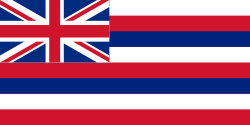 علم Hawaii | |
 شعار Hawaii | |
| رموز حية | |
|---|---|
| الطائر | Nene |
| السمك | Humuhumunukunukuāpuaʻa |
| الزهرة | Pua aloalo |
| الحشرة | Pulelehua |
| الشجرة | Kukui tree |
| رموز جامدة | |
| الرقصة | Hula |
| الطعام | Kalo (taro) |
| الحجر الكريم | ʻĒkaha kū moana (black coral) |
| الرياضة | Heʻe nalu (surfing) |
| علامة طريق ولائي | |
 | |
| ربع دولار الولاية | |
 طـُرِح في 2008 | |
| قوائم رموز الولايات الأمريكية | |
هاوائي أو هاواي ( Hawaii ؛ /həˈwaɪ.i/ (![]() استمع) hə-WY-ee;[9] بالهاواي: [Hawaiʻi] Error: {{Lang}}: text has italic markup (help) [həˈvɐjʔi, həˈwɐjʔi]) هي ولاية أمريكية على شكل أرخبيل من الجزر في المحيط الهادي تبلغ مساحته 166,642 كم. بحسب إحصائات السكان لعام 2000، فإن عدد سكان هاواي هو 1,211,537 نسمة. هونولولو هي العاصمة وأكبر المدن، تتكون هاوائي من 19 جزيرة رئيسية.
استمع) hə-WY-ee;[9] بالهاواي: [Hawaiʻi] Error: {{Lang}}: text has italic markup (help) [həˈvɐjʔi, həˈwɐjʔi]) هي ولاية أمريكية على شكل أرخبيل من الجزر في المحيط الهادي تبلغ مساحته 166,642 كم. بحسب إحصائات السكان لعام 2000، فإن عدد سكان هاواي هو 1,211,537 نسمة. هونولولو هي العاصمة وأكبر المدن، تتكون هاوائي من 19 جزيرة رئيسية.
Hawaii consists of 137 volcanic islands that comprise almost the entire Hawaiian archipelago (the exception, which is outside the state, is Midway Atoll). Spanning 1،500 ميل (2،400 km), the state is physiographically and ethnologically part of the Polynesian subregion of Oceania.[10] Hawaii's ocean coastline is consequently the fourth-longest in the U.S., at about 750 ميل (1،210 km).[ث] The eight main islands, from northwest to southeast, are Niʻihau, Kauaʻi, Oʻahu, Molokaʻi, Lānaʻi, Kahoʻolawe, Maui, and Hawaiʻi, after which the state is named; the latter is often called the "Big Island" or "Hawaii Island" to avoid confusion with the state or archipelago. The uninhabited Northwestern Hawaiian Islands make up most of the Papahānaumokuākea Marine National Monument, the largest protected area in the U.S. and the fourth-largest in the world.
هاواي هي آخر الولايات التي إنضمت إلى الإتحاد الأمريكي، ولدى الولاية العديد مما يميزها عن غيرها. فبالإضافة إلى إحتلالها لآخر حد في الجنوب الأمريكي، بمعنى أنه لا توجد ولاية أخرى تقع جنوبها، فهي الولاية الوحيدة التي تقع بالكامل في المناطق الاستوائية. وكواحدة من الولايتين اللتان تقعان خارج التواصل الجغرافي للولايات المتحدة (الولاية الأخرى هي ألاسكا)، هي الوحيدة التي لا ليس لها أراضي تابعة لأي قارة وهي الوحيدة التي تزداد مساحتها باستمرار بسبب النشاط البركاني وتدفق الحمم البركانية، وبشكل خاص في جزيرة كيلاو Kīlauea. سكانيا، هي الولاية الأمريكية الوحيدة التي لا يوجد فيها أغلبية من البيض كما أنها واحدة من ثلاث فقط لا يشكل فيها البيض ذوي الأصول غير الأمريكية الجنوبية والوسطى أغلبية وفيها نسبة عالية من الأمريكيين الآسيويين. بيئيا وزراعيا، تعتبر هاواي عاصمة الأنواع المهددة بالانقراض في العالم وهي المكان الوحيد الذي تعتبر فيه صناعة القهوة جزءا من الإنتاج الصناعي في الولايات الأمريكية المتحدة. كما أن من أهم منتجات هاواي الزراعية هي الأناناس والموز وقصب السكر وجوز الهند.
اكتشفها الكابتن جيمس كوك عام 1778 م وظلت تابعة للتاج البريطاني فترة طويلة، وكانت في تلك الفترة تحت حكم 4 ملوك محليين، استطاعت الملكة ليليوكالاتي توحيدها في مملكة واحدة، وكانت تأمل أن تنضم للولايات المتحدة، إلا أن الولايات المتحدة رفضت فكرة الضم في بادئ الأمر، ثم أعلنت بها جمهورية 1884 من جانب الأمريكين المقيمين بها، وفي عام 1898 م صوت الكونجرس في صالح ضم هاواي، وأصبحت جزء من الولايات المتحدة، وتكونت ولاية هاواي عام 1900 م.
Historically dominated by a plantation economy, Hawaii remains a major agricultural exporter due to its fertile soil and uniquely tropical climate in the U.S. Its economy has gradually diversified since the mid-20th century, with tourism and military defense becoming the two largest sectors. The state attracts visitors, surfers, and scientists with its diverse natural scenery, warm tropical climate, abundant public beaches, oceanic surroundings, active volcanoes, and clear skies on the Big Island. Hawaii hosts the United States Pacific Fleet, the world's largest naval command, as well as 75,000 employees of the Defense Department.[11] Hawaii's isolation results in one of the highest costs of living in the U.S. However, Hawaii is the third-wealthiest state,[11] and residents have the longest life expectancy of any U.S. state, at 80.7 years.[12]
أصل الكلمة
The State of Hawaii derives its name from the name of its largest island, Hawaiʻi. A common explanation of the name of Hawaiʻi is that it was named for Hawaiʻiloa, a figure from Hawaiian oral tradition. He is said to have discovered the islands when they were first settled.[13][14]
The Hawaiian language word Hawaiʻi is very similar to Proto-Polynesian Sawaiki, with the reconstructed meaning "homeland."[ج] Cognates of Hawaiʻi are found in other Polynesian languages, including Māori (Hawaiki), Rarotongan (ʻAvaiki) and Samoan (Savaiʻi). According to linguists Pukui and Elbert,[16] "elsewhere in Polynesia, Hawaiʻi or a cognate is the name of the underworld or of the ancestral home, but in Hawaii, the name has no meaning".[17]
Spelling of state name
In 1978, Hawaiian was added to the Constitution of the State of Hawaii as an official state language alongside English.[18] The title of the state constitution is The Constitution of the State of Hawaii. Article XV, Section 1 of the Constitution uses The State of Hawaii.[19] Diacritics were not used because the document, drafted in 1949,[20] predates the use of the ʻokina ⟨ʻ⟩ and the kahakō in modern Hawaiian orthography. The exact spelling of the state's name in the Hawaiian language is Hawaiʻi.[ح] In the Hawaii Admission Act that granted Hawaiian statehood, the federal government used Hawaii for the state name. Official government publications, department and office titles, and the Seal of Hawaii use the traditional spelling with no symbols[contradictory] for glottal stops or vowel length.[21][مطلوب مصدر أفضل]
الجغرافيا والبيئة
There are eight main Hawaiian islands. Seven are inhabited, but only six are open to tourists and locals. Niʻihau is privately managed by brothers Bruce and Keith Robinson; access is restricted to those who have their permission. This island is also home to native Hawaiians. Access to uninhabited Kahoʻolawe island is also restricted and anyone who enters without permission will be arrested. This island may also be dangerous since it was a military base during the world wars and could still have unexploded ordnance.
| الجزيرة | اسم التدليل | الموقع | المساحة | أعلى نقطة | الارتفاع | السكان (في 2010) |
الكثافة السكانية | Age (Ma)[22] |
|---|---|---|---|---|---|---|---|---|
| هاواي[23] | الجزيرة الكبيرة | 19°34′N 155°30′W / 19.567°N 155.500°W | 4،028.0 sq mi (10،432.5 km2) | Mauna Kea | 13،796 ft (4،205 m) | 185,079 | 45٫948/sq mi (17٫7407/km2) | 0.4 |
| Kauaʻi[24] | The Garden Isle | 22°05′N 159°30′W / 22.083°N 159.500°W | 552.3 sq mi (1،430.5 km2) | Kawaikini | 5،243 ft (1،598 m) | 66,921 | 121٫168/sq mi (46٫783/km2) | 5.1 |
| Kahoʻolawe[25] | The Target Isle | 20°33′N 156°36′W / 20.550°N 156.600°W | 44.6 sq mi (115.5 km2) | Puʻu Moaulanui | 1،483 ft (452 m) | 0 | 0 | 1.0 |
| Lānaʻi[26] | The Pineapple Isle | 20°50′N 156°56′W / 20.833°N 156.933°W | 140.5 sq mi (363.9 km2) | Lānaʻihale | 3،366 ft (1،026 m) | 3,135 | 22٫313/sq mi (8٫615/km2) | 1.3 |
| Maui[27] | The Valley Isle | 20°48′N 156°20′W / 20.800°N 156.333°W | 727.2 sq mi (1،883.4 km2) | Haleakalā | 10،023 ft (3،055 m) | 144,444 | 198٫630/sq mi (76٫692/km2) | 1.3-0.8 |
| Molokaʻi[28] | The Friendly Isle | 21°08′N 157°02′W / 21.133°N 157.033°W | 260.0 sq mi (673.4 km2) | Kamakou | 4،961 ft (1،512 m) | 7,345 | 28٫250/sq mi (10٫9074/km2) | 1.9-1.8 |
| Niʻihau[29] | The Forbidden Isle | 21°54′N 160°10′W / 21.900°N 160.167°W | 69.5 sq mi (180.0 km2) | Mount Pānīʻau | 1،250 ft (381 m) | 170 | 2٫45/sq mi (0٫944/km2) | 4.9 |
| Oʻahu[30] | The Gathering Place | 21°28′N 157°59′W / 21.467°N 157.983°W | 596.7 sq mi (1،545.4 km2) | Mount Kaʻala | 4،003 ft (1،220 m) | 953,207 | 1٬597٫46/sq mi (616٫78/km2) | 3.7-2.6 |
الطبوغرافيا
تتكون هاواى من (23 ) جزيرة ، أكبرها جزر هاواي ، وماوى وأواهو وبها العاصمة ، ومالاكاس ، ولانا ، ونيهاو ، وكاهولاوي وأرضها عبارة عن قمم سلاسل جبلية بركانية غارقة ، أقدمها الطرف الغربي من هذه المجموعة الجزيرية ، تكثر بها البراكين ، ترتفع بعض قممها إلي أكثر من 13 ألف قدم في جزيرة هاواى ، حيث قمة ماونالوا ، وهي قمة بركانية يتجدد ثوران بركانها. The Hawaiian archipelago is 2،000 mi (3،200 km) southwest of the contiguous United States.[31] Hawaii is the southernmost U.S. state and the second westernmost after Alaska. Like Alaska, Hawaii borders no other U.S. state. It is the only U.S. state not in North America, and the only one completely surrounded by water and entirely an archipelago.
In addition to the eight main islands, the state has many smaller islands and islets. Kaʻula is a small island near Niʻihau. The Northwestern Hawaiian Islands is a group of nine small, older islands northwest of Kauaʻi that extends from Nihoa to Kure Atoll; these are remnants of once much larger volcanic mountains. Across the archipelago are around 130 small rocks and islets, such as Molokini, which are made up of either volcanic or marine sedimentary rock.[32]
Hawaiʻi's tallest mountain Mauna Kea is 13،796 ft (4،205 m) above mean sea level;[33] it is taller than Mount Everest if measured from the base of the mountain, which lies on the floor of the Pacific Ocean and rises about 33،500 أقدام (10،200 m).[34]
الجيولوجيا
The Hawaiian islands were formed by volcanic activity initiated at an undersea magma source called the Hawaiʻi hotspot. The process is continuing to build islands; the tectonic plate beneath much of the Pacific Ocean continually moves northwest and the hotspot remains stationary, slowly creating new volcanoes. Because of the hotspot's location, all active land volcanoes are on the southern half of Hawaiʻi Island. The newest volcano, Kamaʻehuakanaloa (formerly Lōʻihi), is south of the coast of Hawaiʻi Island.
The last volcanic eruption outside Hawaiʻi Island occurred at Haleakalā on Maui before the late 18th century, possibly hundreds of years earlier.[35] In 1790, Kīlauea exploded; it is the deadliest eruption known to have occurred in the modern era in what is now the United States.[36] Up to 5,405 warriors and their families marching on Kīlauea were killed by the eruption.[37] Volcanic activity and subsequent erosion have created impressive geological features. Hawaii Island has the second-highest point among the world's islands.[38]
On the volcanoes' flanks, slope instability has generated damaging earthquakes and related tsunamis, particularly in 1868 and 1975.[39] Catastrophic debris avalanches on the ocean island volcanoes' submerged flanks have created steep cliffs.[40][41]
Kīlauea erupted in May 2018, opening 22 fissure vents on its eastern rift zone. The Leilani Estates and Lanipuna Gardens are within this territory. The eruption destroyed at least 36 buildings and this, coupled with the lava flows and the sulfur dioxide fumes, necessitated the evacuation of more than 2,000 inhabitants from their neighborhoods.[42]
النبيت والوحيش
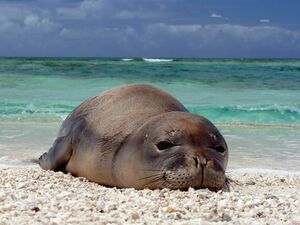
The islands of Hawaiʻi are distant from other land habitats, and life is thought to have arrived there by wind, waves (i.e., by ocean currents), and wings (i.e., birds, insects, and any seeds that they may have carried on their feathers). Hawaiʻi has more endangered species and has lost a higher percentage of its endemic species than any other U.S. state.[43] The endemic plant Brighamia now requires hand pollination because its natural pollinator is presumed to be extinct.[44] The two species of Brighamia—B. rockii and B. insignis—are represented in the wild by around 120 individual plants. To ensure that these plants set seed, biologists rappel down 3،000-قدم (910 m) cliffs to brush pollen onto their stigmas.[45]
Terrestrial ecology
The archipelago's extant main islands have been above the surface of the ocean for less than 10 million years, a fraction of the time biological colonization and evolution have occurred there. The islands are well known for the environmental diversity that occurs on high mountains within a trade winds field. Native Hawaiians developed complex horticultural practices to utilize the surrounding ecosystem for agriculture. Cultural practices developed to enshrine values of environmental stewardship and reciprocity with the natural world, resulting in widespread biodiversity and intricate social and environmental relationships that persist to this day.[46] On a single island, the climate around the coasts can range from dry tropical (less than 20 بوصات أو 510 ميليمتر annual rainfall) to wet tropical; on the slopes, environments range from tropical rainforest (more than 200 بوصات أو 5،100 ميليمتر per year), through a temperate climate, to alpine conditions with a cold, dry climate. The rainy climate impacts soil development, which largely determines ground permeability, affecting the distribution of streams and wetlands.[47][48][49]
Protected areas
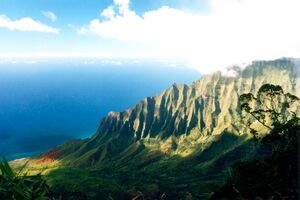
Several areas in Hawaiʻi are under the National Park Service's protection.[50] Hawaii has two national parks: Haleakalā National Park, near Kula on Maui, which features the dormant volcano Haleakalā that formed east Maui; and Hawaii Volcanoes National Park, in the southeast region of Hawaiʻi Island, which includes the active volcano Kīlauea and its rift zones.
There are three national historical parks: Kalaupapa National Historical Park in Kalaupapa, Molokaʻi, the site of a former leper colony; Kaloko-Honokōhau National Historical Park in Kailua-Kona on Hawaiʻi Island; and Puʻuhonua o Hōnaunau National Historical Park, an ancient place of refuge on Hawaiʻi Island's west coast. Other areas under the National Park Service's control include Ala Kahakai National Historic Trail on Hawaiʻi Island and the USS Arizona Memorial at Pearl Harbor on Oʻahu.
President George W. Bush proclaimed the Papahānaumokuākea Marine National Monument on June 15, 2006. The monument covers roughly 140،000 ميل مربع (360،000 km2) of reefs, atolls, and shallow and deep sea out to 50 ميل (80 km) offshore in the Pacific Ocean—an area larger than all the national parks in the U.S. combined.[51]
المناخ
مداري جزري إلا أنه يختلف بين منطقة وأخرى حسب الموقع ونظام التضاريس واتجاه الرياح، والأمطار وفيرة وتسقط معظم أيام السنة مع كثافة هطول الأمطار في شهري نوفمبر وأبريل
Hawaiʻi has a tropical climate. Temperatures and humidity tend to be less extreme because of near-constant trade winds from the east. Summer highs reach around 88 °F (31 °C) during the day, with lows of 75 °F (24 °C) at night. Winter day temperatures are usually around 83 °F (28 °C); at low elevation they seldom dip below 65 °F (18 °C) at night. Snow, not usually associated with the tropics, falls at 13،800 أقدام (4،200 m) on Mauna Kea and Mauna Loa on Hawaii Island in some winter months. Snow rarely falls on Haleakalā. Mount Waiʻaleʻale on Kauaʻi has the second-highest average annual rainfall on Earth, about 460 بوصات (12،000 mm) per year. Most of Hawaii experiences only two seasons; the dry season runs from May to October and the wet season is from October to April.[53]
Overall with climate change, Hawaiʻi is getting drier and hotter.[54][55] The warmest temperature recorded in the state, in Pahala on April 27, 1931, is 100 °F (38 °C), tied with Alaska as the lowest record high temperature observed in a U.S. state.[56] Hawaiʻi's record low temperature is 12 °F (−11 °C) observed in May 1979, on the summit of Mauna Kea. Hawaiʻi is the only state to have never recorded subzero Fahrenheit temperatures.[56]
Climates vary considerably on each island; they can be divided into windward and leeward (koʻolau and kona, respectively) areas based upon location relative to the higher mountains. Windward sides face cloud cover.[57]
القضايا البيئية
Hawaii has a decades-long history of hosting more military space for the United States than any other territory or state.[58] This record of military activity has taken a sharp toll on the environmental health of the Hawaiian archipelago, degrading its beaches and soil, and making some places entirely unsafe due to unexploded ordnance.[59] According to scholar Winona LaDuke: "The vast militarization of Hawaii has profoundly damaged the land. According to the Environmental Protection Agency, there are more federal hazardous waste sites in Hawaii – 31 – than in any other U.S. state."[60] Hawaii State Representative Roy Takumi writes in "Challenging U.S. Militarism in Hawai'i and Okinawa" that these military bases and hazardous waste sites have meant "the confiscation of large tracts of land from native peoples" and quotes late Hawaiian activist George Helm as asking: "What is national defense when what is being destroyed is the very thing the military is entrusted to defend, the sacred land of Hawaiʻi?"[58] Contemporary Indigenous Hawaiians are still protesting the occupation of their homelands and environmental degradation due to increased militarization in the wake of 9/11.[61]
After the rise of sugarcane plantations in the mid 19th century, island ecology changed dramatically. Plantations require massive quantities of water, and European and American plantation owners transformed the land in order to access it, primarily by building tunnels to divert water from the mountains to the plantations, constructing reservoirs, and digging wells.[62] These changes have made lasting impacts on the land and continue to contribute to resource scarcity for Native Hawaiians today.[62][63]
According to Stanford scientist and scholar Sibyl Diver, Indigenous Hawaiians engage in a reciprocal relationship with the land, "based on principles of mutual caretaking, reciprocity and sharing".[64] This relationship ensures the longevity, sustainability, and natural cycles of growth and decay, as well as cultivating a sense of respect for the land and humility towards one's place in an ecosystem.[64]
The tourism industry's ongoing expansion and its pressure on local systems of ecology, cultural tradition and infrastructure is creating a conflict between economic and environmental health.[65] In 2020, the Center for Biological Diversity reported on the plastic pollution of Hawaii's Kamilo beach, citing "massive piles of plastic waste".[66] Invasive species are spreading, and chemical and pathogenic runoff is contaminating groundwater and coastal waters.[67]
تتكون هاواى من (23 ) جزيرة ، أكبرها جزر هاواي ، وماوى وأواهو وبها العاصمة ، ومالاكاس ، ولانا ، ونيهاو ، وكاهولاوي وأرضها عبارة عن قمم سلاسل جبلية بركانية غارقة ، أقدمها الطرف الغربي من هذه المجموعة الجزيرية ، تكثر بها البراكين ، ترتفع بعض قممها إلي أكثر من 13 ألف قدم في جزيرة هاواى ، حيث قمة ماونالوا ، وهي قمة بركانية يتجدد ثوران بركانها .
[

| درجات الحرارة العظمى والصغرى شهريا (°F) في مختلف مدن هاواي[68] | ||||||||||||
| City | Jan | Feb | Mar | Apr | May | Jun | Jul | Aug | Sep | Oct | Nov | Dec |
|---|---|---|---|---|---|---|---|---|---|---|---|---|
| Hilo | 79/64 | 79/64 | 79/65 | 79/66 | 81/67 | 82/68 | 82/69 | 83/69 | 83/69 | 83/68 | 81/67 | 80/65 |
| هونولولو | 80/66 | 81/65 | 82/67 | 83/68 | 85/70 | 87/72 | 88/74 | 89/75 | 89/74 | 87/73 | 84/71 | 82/68 |
| Kahului | 80/63 | 81/63 | 82/65 | 82/66 | 84/67 | 86/69 | 87/71 | 88/71 | 88/70 | 87/69 | 84/68 | 82/65 |
| Līhuʻe | 78/65 | 78/66 | 78/67 | 79/69 | 81/70 | 83/73 | 84/74 | 85/74 | 85/74 | 84/73 | 81/71 | 79/68 |
السطح
يقسم الجغرافيون تلك الجزر إلى ثلاث مجموعات رئيسية:
1- ثماني جزر رئيسية في الجنوب الشرقي
2- جزر صخرية صغيرة في الوسط
3- جزر مرجانية ورملية في الشمال الغربي. وهذه الجزر قد تكونت بفعل البراكين التي انبثقت من قاع المحيط.
ومعظم الجزر الثماني الرئيسية شواطئها رملية بيضاء، على حين أن الشواطئ الأخرى يكسوها رمل أسود من مسحوق الحمم البركانية. وتبرز صخور من الحمم السوداء شاخصة من الماء، بحذاء بعض السواحل. وفي أماكن كثيرة، توجد منحدرات صخرية شاهقة عند الشواطئ.
وتنمو النباتات والأشجار المدارية الكثيفة، حيثما وجدت التربة الخصبة والأمطار الغزيرة، وتنفرد هاواي بنباتات محلية ليس لها مثيل في العالم. وليس في هاواي من الحيوانات البرية إلا القليل، غير أن معظم حيواناتها من الصنف النادر الذي لا يراه الإنسان إلا في تلك الجزر.
والجزر الثماني الرئيسية الهامة في هاواي، وفق ترتيبها من الشرق إلى الغرب، هي: هاواي، ماوي، كاهولاوي مولوكاي، لاناي، أواهو، كاواي وأخيراً نيهاو.
وجزيرة هاواي التي كثيراً مايسمونها الجزيرة الكبرى، هي الكبرى فعلا بين تلك الجزر، وتحاط سواحلها الشمالية الشرقية والجنوبية الشرقية بالمنحدرات الصخرية الشاهقة الارتفاع. وتتغلغل هنا وهناك مساقط مائية فضية اللون صابَّةً في المحيط الجاري من تحتها، وقصب السكر هو المحصول الرئيسي في تلك الجزيرة.
والبركانان الوحيدان النشطان في مجموعة الجزر يقعان في جزيرة هاواي، وهما :ماونا لووا، وكيلاويا. ويمر طريق واسع بجوار بركان كيلاويا. ويجتذب منظر تلك الحمم البركانية المشتعلة في فوهة البركان العديد من الزائرين.
وكثيراً مايطلقون على جزيرة ماوي: جزيرة الوادي؛ حيث تتدفق جداول كثيرة ضيقة لتخترق الجبلين البركانيين اللذين تتكون منهما الجزيرة. ويوجد بين الجبلين برزخ عريض منخفض يحفل بمزارع قصب السكر. أما جزيرة هاكولاي فإنها أصغر تلك الجزر، وهي جزيرة جافة تعصف بها العواصف دائما، ولا يسكنها أحد من الناس.
وأما جزيرة ملوكاي فتسمى، الجزيرة حلوة المعشر، وذلك من الأدب الجم الذى يستقبل به أهلها الزائرين. وهي تتكون من ثلاث مناطق: ملوكاي الغربية، وهي هضبة عريضة المساحة جافة يغطي معظمها مزارع تربية الأبقار، والمنطقة الشرقية، وتتكون من جبال وعرة المسالك وجداول منحدرة عميقة،ثم المنطقة الوسطى وتتكون من سهل خصيب ينمو به الأناناس والمحاصيل الزراعية الأخرى. وأما لاناي (جزيرة الأناناس)، فكل أرضها صالحة لزراعة الأناناس. وتمتلك شركة كاسل وكوك المتحدة مبتدعة صنف الأناناس المسمى دول ومنتجاته، 98% من الجزيرة، والبقية تمتلكها ولاية هاواي. أما جزيرة أواهو وهي موطن 80% من السكان، فيطلقون عليها مكان التجمع، وتتكون من سلسلتي جبال يفصل إحداهما عن الأخرى واد فسيح، وبها ميناء بيرل هاربر، وهو واحد من أكبر المرافئ الطبيعية في المحيط الهادئ، ويقع على الساحل الجنوبي للجزيرة. وأما جزيرة كاواي فيطلقون عليها الجزيرة الحديقة نسبة لخضرتها وحدائقها الغناء. والجزيرة دائرية الشكل في وسطها قمة كاويكيني البالغ ارتفاعها 1576م.
وجزيرة نيهاو تعرف باسم الجزيرة المحرَّمة فلا يزورها أحد، كائنًا من كان إلا بإذن من مالكتها. فقد ابتاعت إليزابيث سنكلير، معظم الجزيرة من الملك كاميها ميها الخامس، وكان ذلك في عام 1864م، ولاتزال أسرة روبنسون المنحدرة من صلب إليزابث سنكلير، تمتلك الجزيرة حيث تُدير مزرعة لتربية الأبقار تكاد تغطي الجزيرة كلها.
التاريخ
قالب:HI history Hawaiʻi is one of two U.S. states that were widely recognized independent nations before becoming U.S. states. The Kingdom of Hawaiʻi was sovereign from 1810 until 1893, when resident American and European capitalists and landholders overthrew the monarchy. Hawaiʻi was an independent republic from 1894 until August 12, 1898, when it officially became a U.S. territory. Hawaiʻi was admitted as a U.S. state on August 21, 1959.[69]
First human settlement – Ancient Hawaiʻi (1000–1778)



جاء البولينيزيون إلى جزر هاواي في قوارب عملاقة من جزر المحيط الهادئ الأخرى منذ نحو ألفي سنة،
Based on archaeological evidence, the earliest habitation of the Hawaiian Islands appears to date between 1000 and 1200 CE. The first wave was probably by Polynesian settlers from the Marquesas Islands,[71][محل شك] and a second wave of migration from Raiatea and Bora Bora took place in the 11 century. The date of the human discovery and habitation of the Hawaiian Islands is the subject of academic debate.[72] Some archaeologists and historians think it was a later wave of immigrants from Tahiti around 1000 CE who introduced a new line of high chiefs, the kapu system, the practice of human sacrifice, and the building of heiau.[73] This later immigration is detailed in Hawaiian mythology (moʻolelo) about Paʻao. Other authors say there is no archaeological or linguistic evidence of a later influx of Tahitian settlers and that Paʻao must be regarded as a myth.[73]
The islands' history is marked by a slow, steady growth in population and the size of the chiefdoms, which grew to encompass whole islands. Local chiefs, called aliʻi, ruled their settlements, and launched wars to extend their influence and defend their communities from predatory rivals. Ancient Hawaiʻi was a caste-based society, much like that of Hindus in India.[74] Population growth was facilitated by ecological and agricultural practices that combined upland agriculture (manuka), ocean fishing (makai), fishponds and gardening systems. These systems were upheld by spiritual and religious beliefs, like the lokahi, that linked cultural continuity with the health of the natural world.[46] According to Hawaiian scholar Mililani Trask, the lokahi symbolizes the "greatest of the traditions, values, and practices of our people ... There are three points in the triangle—the Creator, Akua; the peoples of the earth, Kanaka Maoli; and the land, the ʻaina. These three things all have a reciprocal relationship."[46][75]
European arrival
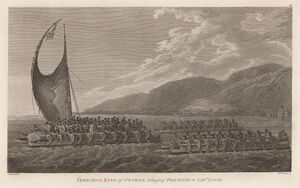
ونزل القائد جيمس كوك، وهو من البحرية البريطانية على تلك الأرض في الثامن عشر من شهر يناير عام 1778م، حيث اتجر مع سكان جزر هاواي الذين اعتبروه رئيسًا مهيـبًا ذا قدرات سماوية خارقة. وتبع قدوم كوك إلى تلك الأرض تجار آخرون كثيرو العدد، حاملين معهم المواشي والمصنوعات والمزروعات من الأقطار الأخرى، وفي أوائل القرن التاسع عشر، مات العديد من سكان جزر هاواي بسبب الأمراض التي وفدت إليهم من بلدان أخرى من العالم.
The 1778 arrival of British explorer Captain James Cook marked the first documented contact by a European explorer with Hawaiʻi; early British influence can be seen in the design of the flag of Hawaiʻi, which bears the Union Jack in the top-left corner. Cook named the archipelago "the Sandwich Islands" in honor of his sponsor John Montagu, 4th Earl of Sandwich, publishing the islands' location and rendering the native name as Owyhee. The form "Owyhee" or "Owhyhee" is preserved in the names of certain locations in the American part of the Pacific Northwest, among them Owyhee County and Owyhee Mountains in Idaho, named after three native Hawaiian members of a trapping party who went missing in the area.[76]
Spanish explorers may have arrived in the Hawaiian Islands in the 16th century, 200 years before Cook's first documented visit in 1778. Ruy López de Villalobos commanded a fleet of six ships that left Acapulco in 1542 bound for the Philippines, with a Spanish sailor named Juan Gaetano aboard as pilot. Gaetano's reports describe an encounter with either Hawaiʻi or the Marshall Islands.[77][78][مطلوب مصدر أفضل] If López de Villalobos's crew spotted Hawaiʻi, Gaetano would thus be the first European to see the islands. Most scholars have dismissed these claims due to a lack of credibility.[79][80][81]
Nonetheless, Spanish archives contain a chart that depicts islands at the same latitude as Hawaiʻi, but with a longitude ten degrees east of the islands. In this manuscript, Maui is named La Desgraciada (The Unfortunate Island), and what appears to be Hawaiʻi Island is named La Mesa (The Table). Islands resembling Kahoʻolawe', Lānaʻi, and Molokaʻi are named Los Monjes (The Monks).[82] For two and a half centuries, Spanish galleons crossed the Pacific from Mexico along a route that passed south of Hawaiʻi on their way to Manila. The exact route was kept secret to protect the Spanish trade monopoly against competing powers. Hawaiʻi thus maintained independence, despite being on a sea route east–west between nations that were subjects of the Viceroyalty of New Spain, an empire that exercised jurisdiction over many subject civilizations and kingdoms on both sides of the Pacific.[83]
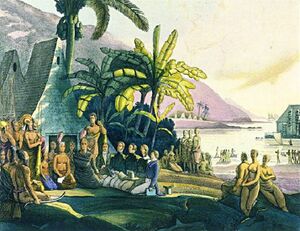
Despite such contested claims, Cook is generally considered the first European to land at Hawaiʻi, having visited the Hawaiian Islands twice. As he prepared for departure after his second visit in 1779, a quarrel ensued as he took temple idols and fencing as "firewood",[84] and a minor chief and his group stole a boat from his ship. Cook abducted the King of Hawaiʻi Island, Kalaniʻōpuʻu, and held him for ransom aboard his ship to gain return of Cook's boat, as this tactic had previously worked in Tahiti and other islands.[85] Instead, the supporters of Kalaniʻōpuʻu attacked, killing Cook and four sailors as Cook's party retreated along the beach to their ship. The ship departed without retrieving the stolen boat.
After Cook's visit and the publication of several books relating his voyages, the Hawaiian Islands attracted many European and American explorers, traders, and whalers, who found the islands to be a convenient harbor and source of supplies. These visitors introduced diseases to the once-isolated islands, causing the Hawaiian population to drop precipitously.[86] Native Hawaiians had no resistance to Eurasian diseases, such as influenza, smallpox and measles. By 1820, disease, famine and wars between the chiefs killed more than half of the Native Hawaiian population.[87] During the 1850s, measles killed a fifth of Hawaiʻi's people.[88]
Historical records indicate the earliest Chinese immigrants to Hawaiʻi originated from Guangdong Province; a few sailors arrived in 1778 with Cook's journey, and more in 1789 with an American trader who settled in Hawaiʻi in the late 18th century. It is said that Chinese workers introduced leprosy by 1830, and as with the other new infectious diseases, it proved damaging to the Hawaiians.[89]
Kingdom of Hawaiʻi
House of Kamehameha
وقد حكم الجزر في الفترة التي قضاها كوك زائرًا، فئة من الرؤساء المحليين، ومنهم كاميها ميها حيث تغلب عليهم، وصارت إليه السيادة على جزر هاواي كلها بعد حرب طاحنة، بدأت عام 1782م، ودامت عشر سنوات استولى فيها على الجزر الرئيسية الأخرى ووحدها. ثم خدم الرؤساء المحليون الآخرون البلاد بوصفهم محافظين تحت حكم الملك كاميها ميها الأول ملك مملكة هاواي.
وبين عامي 1811 و1880، قامت هاواي بشحن كميات كبيرة من خشب الصندل إلى بلاد الصين، وقد وفرت النقود التي جنتها من تلك التجارة مصدراً رئيسياً من الدخل للملك كاميها ميها الأول، ولملكين آخرين من بعده لجزر هاواي.
وفي أوائل القرن التاسع عشر، أقبلت مئات من سفن صيادي الحيتان وكانت معظمها من الولايات المتحدة الأمريكية زائرين البلاد كل عام. وقد شكلت مبيعات التموين لتلك السفن أكبر عائد من المال لسكان هاواي حتى ستينيات القرن التاسع عشر. وفي عام 1819، تولى ابن كاميها ميها الأول، ليهوليهو الملك باسم: كاميها ميها الثاني، وما لبث الملك الجديد أن ألغى الديانات المحلية في هاواي، حتى إذا جاء العام1820م، كان قد تم تحويل معـظم سكان جزر هاواي إلى الدين النصراني على يد البعثات التنصيرية البروتستانتية والمدرسين من الولايات المتحدة.
وما لبثت أن وصلت إلى هناك البعثات التنصيرية من الرومان الكاثوليك وكان ذلك في عام 1827م، غير أن السكان ردوهم على أعقابهم عام 1831م، وزجوا بالكثيرين ممن اعتنقوا الدين الكاثوليكي من أهل الجزر في السجون، بيد أنه في شهر يوليو عام 1839م، حاصرت سفينة فرنسية مدينة هونولولو، حتى وافقت الحكومة على إطلاق سراح السجناء ومنح حرية عبادة الدين الكاثوليكي للشعب في هاواي. ومنذ عام 1854م حتى عام1872م، أصبحت تلك الجزر بوتقة ينصهر فيها شعوب من شتى الدول. وإذ لم يف السكان بحاجة مزارع السكر، جلب أصحاب تلك المزارع العمال من البلدان الأخرى.
وفي عام 1874، ارتقى عرش هاواي الملك كالاكاوا الملقب بالملك المرح. وإبان حكمه، عادت إلى الحياة في هاواي الموسيقى الشعبية المعروفة بالهولا، وبصحبتها الكثير من العادات الوطنية المألوفة في هاواي، والتي كان الحكام السابقون قد أوقفوها بناء على طلب بعثات التنصير النصرانية. وفي حكم كالاكاوا أيضًا، صارت زراعة قصب السكر صناعة كبرى، وقام زُرّاع قصب السكر بشحن معظم محصولهم إلى الولايات المتحدة، أما صناعة الأناناس في هاواي، فقد بدأت بعد أن تم شحن ألف شجرة منه إلى هناك عن طريق جامايكا، وكان ذلك نحو عام 1885م.
During the 1780s, and 1790s, chiefs often fought for power. After a series of battles that ended in 1795, all inhabited islands were subjugated under a single ruler, who became known as King Kamehameha the Great. He established the House of Kamehameha, a dynasty that ruled the kingdom until 1872.[90]
After Kamehameha II inherited the throne in 1819, American Protestant missionaries to Hawaiʻi converted many Hawaiians to Christianity. Missionaries have argued that one function of missionary work was to "civilize" and "purify" perceived heathenism in the New World. This carried into Hawaiʻi.[91][92][93][94][95][96] According to historical archaeologist James L. Flexner, "missionaries provided the moral means to rationalize conquest and wholesale conversion to Christianity".[91] But rather than abandon traditional beliefs entirely, most native Hawaiians merged their Indigenous religion with Christianity.[91][93][92] Missionaries used their influence to end many traditional practices, including the kapu system, the prevailing legal system before European contact, and heiau, or "temples" to religious figures.[91][97][98] Kapu, which typically translates to "the sacred", refers to social regulations (like gender and class restrictions) that were based upon spiritual beliefs. Under the missionaries' guidance, laws against gambling, consuming alcohol, dancing the hula, breaking the Sabbath, and polygamy were enacted.[92] Without the kapu system, many temples and priestly statuses were jeopardized, idols were burned, and participation in Christianity increased.[92][94] When Kamehameha III inherited the throne at age 12, his advisors pressured him to merge Christianity with traditional Hawaiian ways. Under the guidance of his kuhina nui (his mother and coregent Elizabeth Kaʻahumanu) and British allies, Hawaiʻi turned into a Christian monarchy with the signing of the 1840 Constitution.[99][94] Hiram Bingham I, a prominent Protestant missionary, was a trusted adviser to the monarchy during this period. Other missionaries and their descendants became active in commercial and political affairs, leading to conflicts between the monarchy and its restive American subjects.[100] Missionaries from the Roman Catholic Church and from The Church of Jesus Christ of Latter-day Saints were also active in the kingdom, initially converting a minority of the Native Hawaiian population, but later becoming the first and second largest religious denominations on the islands, respectively.[101][102][103][104] Missionaries from each major group administered to the leper colony at Kalaupapa on Molokaʻi, which was established in 1866 and operated well into the 20th century. The best known were Father Damien and Mother Marianne Cope, both of whom were canonized in the early 21st century as Roman Catholic saints.
The death of the bachelor King Kamehameha V—who did not name an heir—resulted in the popular election of Lunalilo over Kalākaua. Lunalilo died the next year, also without naming an heir. In 1874, the election was contested within the legislature between Kalākaua and Emma, Queen Consort of Kamehameha IV. After riots broke out, the U.S. and Britain landed troops on the islands to restore order. The Legislative Assembly chose King Kalākaua as monarch by a vote of 39 to 6 on February 12, 1874.[105]
1887 Constitution and overthrow preparations
وفي عام 1893، قامت في البلاد ثورة لم يُرق فيها نقطة دم واحدة، قادها تسعة أمريكيين وبريطانيان وألمانيان، أقصت الملكة ليليوكلاني عن العرش وكونوا من أنفسهم ومن أتباعهم جمهورية في هاواي، وقام مديرو المؤسسات التجارية من الأمريكيين بالإشراف على الجمهورية الجديدة، لكنه ولأسباب تجارية محضة، أراد هؤلاء المديرون أن تصبح تلك الجزر أرضاً أمريكية.
In 1887, Kalākaua was forced to sign the 1887 Constitution of the Kingdom of Hawaiʻi. Drafted by white businessmen and lawyers, the document stripped the king of much of his authority. It established a property qualification for voting that effectively disenfranchised most Hawaiians and immigrant laborers and favored the wealthier, white elite. Resident whites were allowed to vote but resident Asians were not. As the 1887 Constitution was signed under threat of violence, it is known as the Bayonet Constitution. King Kalākaua, reduced to a figurehead, reigned until his death in 1891. His sister, Queen Liliʻuokalani, succeeded him; she was the last monarch of Hawaiʻi.[106]
In 1893, Liliʻuokalani announced plans for a new constitution to proclaim herself an absolute monarch. On January 14, 1893, a group of mostly Euro-American business leaders and residents formed the Committee of Safety to stage a coup d'état against the kingdom and seek annexation by the United States. U.S. Government Minister John L. Stevens, responding to a request from the Committee of Safety, summoned a company of U.S. Marines. The queen's soldiers did not resist. According to historian William Russ, the monarchy was unable to protect itself.[107] In Hawaiian Autonomy, Liliʻuokalani states:
If we did not by force resist their final outrage, it was because we could not do so without striking at the military force of the United States. Whatever constraint the executive of this great country may be under to recognize the present government at Honolulu has been forced upon it by no act of ours, but by the unlawful acts of its own agents. Attempts to repudiate those acts are vain.[108][109]
In a message to Sanford B. Dole, Liliʻuokalani states:
Now to avoid any collision of armed forces and perhaps the loss of life, I do under this protest, and impelled by said force, yield my authority until such time as the Government of the United States shall, upon the facts being presented to it, undo the action of its representatives and reinstate me in the authority which I claim as the constitutional sovereign of the Hawaiian Islands.[110][111]
Overthrow of 1893 – Republic of Hawaiʻi (1894–1898)
The treason trials of 1892 brought together the main players in the 1893 overthrow. American Minister John L. Stevens voiced support for Native Hawaiian revolutionaries; William R. Castle, a Committee of Safety member, served as a defense counsel in the treason trials; Alfred Stedman Hartwell, the 1893 annexation commissioner, led the defense effort; and Sanford B. Dole ruled as a supreme court justice against acts of conspiracy and treason.[112]
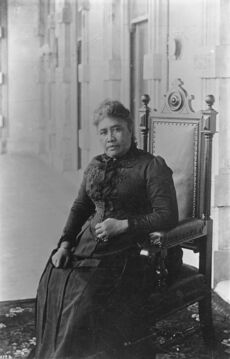
On January 17, 1893, a small group of sugar and pineapple-growing businessmen, aided by the American minister to Hawaii and backed by heavily armed U.S. soldiers and marines, deposed Queen Liliʻuokalani and installed a provisional government composed of members of the Committee of Safety.[113] According to scholar Lydia Kualapai and Hawaii State Representative Roy Takumi, this committee was formed against the will of Indigenous Hawaiian voters, who constituted the majority of voters at the time, and consisted of "thirteen white men" according to scholar J Kehaulani Kauanui.[114][58][61] The United States Minister to the Kingdom of Hawaii (John L. Stevens) conspired with U.S. citizens to overthrow the monarchy.[115] After the overthrow, Sanford B. Dole, a citizen of Hawaii and cousin to James Dole, owner of Hawaiian Fruit Company, a company that benefited from the annexation of Hawaii, became president of the republic when the Provisional Government of Hawaiʻi ended on July 4, 1894.[116][117]
Controversy ensued in the following years as the queen tried to regain her throne. Scholar Lydia Kualapai writes that Liliʻuokalani had "yielded under protest not to the counterfeit Provisional Government of Hawaii but to the superior force of the United States of America" and wrote letters of protest to the president requesting a recognizance of allyship and a reinstatement of her sovereignty against the recent actions of the Provisional Government of Hawaii.[114] Following the January 1893 coup that deposed Liliʻuokalani, many royalists were preparing to overthrow the white-led Republic of Hawaiʻi oligarchy. Hundreds of rifles were covertly shipped to Hawaii and hidden in caves nearby. As armed troops came and went, a Republic of Hawaiʻi patrol discovered the rebel group. On January 6, 1895, gunfire began on both sides and later the rebels were surrounded and captured. Over the next 10 days several skirmishes occurred, until the last armed opposition surrendered or were captured. The Republic of Hawaiʻi took 123 troops into custody as prisoners of war. The mass arrest of nearly 300 more men and women, including Queen Liliʻuokalani, as political prisoners was intended to incapacitate the political resistance against the ruling oligarchy. In March 1895, a military tribunal convicted 170 prisoners of treason and sentenced six troops to be "hung by the neck" until dead, according to historian Ronald Williams Jr. The other prisoners were variously sentenced to from five to thirty-five years' imprisonment at hard labor, while those convicted of lesser charges received sentences from six months' to six years' imprisonment at hard labor.[118] The queen was sentenced to five years in prison, but spent eight months under house arrest until she was released on parole.[119] The total number of arrests related to the 1895 Kaua Kūloko was 406 people on a summary list of statistics, published by the government of the Republic of Hawaiʻi.[118]
The administration of President Grover Cleveland commissioned the Blount Report, which concluded that the removal of Liliʻuokalani had been illegal. Commissioner Blount found the U.S. and its minister guilty on all counts including the overthrow, the landing of the marines, and the recognition of the provisional government.[110] In a message to Congress, Cleveland wrote:
And finally, but for the lawless occupation of Honolulu under false pretexts by the United States forces, and but for Minister Stevens' recognition of the provisional government when the United States forces were its sole support and constituted its only military strength, the Queen and her Government would never have yielded to the provisional government, even for a time and for the sole purpose of submitting her case to the enlightened justice of the United States.[110][113] By an act of war, committed with the participation of a diplomatic representative of the United States and without authority of Congress, the Government of a feeble but friendly and confiding people has been overthrown. A substantial wrong has thus been done which a due regard for our national character as well as the rights of the injured people requires we should endeavor to repair. The provisional government has not assumed a republican or other constitutional form, but has remained a mere executive council or oligarchy, set up without the assent of the people. It has not sought to find a permanent basis of popular support and has given no evidence of an intention to do so.[113][110]
The U.S. government first demanded that Queen Liliʻuokalani be reinstated, but the Provisional Government refused. On December 23, 1893, the response from the Provisional Government of Hawaii, authored by President Sanford B. Dole, was received by Cleveland's representative Minister Albert S. Willis and emphasized that the Provisional Government of Hawaii "unhesitatingly" rejected the demand from the Cleveland Administration.[114]
Congress conducted an independent investigation, and on February 26, 1894, submitted the Morgan Report, which found all parties, including Minister Stevens—with the exception of the queen—"not guilty" and not responsible for the coup.[120] Partisans on both sides of the debate questioned the accuracy and impartiality of both the Blount and Morgan reports over the events of 1893.[107][121][122][123]
In 1993, Congress passed a joint Apology Resolution regarding the overthrow; it was signed by President Bill Clinton. The resolution apologized and said that the overthrow was illegal in the following phrase: "The Congress—on the occasion of the 100th anniversary of the illegal overthrow of the Kingdom of Hawaiʻi on January 17, 1893, acknowledges the historical significance of this event which resulted in the suppression of the inherent sovereignty of the Native Hawaiian people."[115] The Apology Resolution also "acknowledges that the overthrow of the Kingdom of Hawaiʻi occurred with the active participation of agents and citizens of the United States and further acknowledges that the Native Hawaiian people never directly relinquished to the United States their claims to their inherent sovereignty as a people over their national lands, either through the Kingdom of Hawaiʻi or through a plebiscite or referendum".[123][115]
Annexation – Territory of Hawaiʻi (1898–1959)

وبحلول عام 1898 ورغم بعض المعارضة من سكان هاواي، قامت الولايات المتحدة بضم هاواي، وعدّتها إحدى ممتلكاتها، وفي عام 1900، صارت هاواي أرضًا أمريكية.
وقبيل الحرب العالمية الأولى (1914 – 1918) شرعت البحرية الأمريكية في بناء قاعدة بحرية كبيرة في بيرل هاربر، وهي التي هاجمتها اليابان في السابع من شهر ديسمبر عام 1941م، لتزج بالولايات المتحدة الأمريكية في خضم الحرب العالمية الثانية.
وكان أول مشروعات القوانين الخاصة بتنظيم الولايات قد قدم إلى مجلس النواب الأمريكي عام 1919. وأخيرًا وفي عام 1959، أصبحت هاواي أحدث ولاية في الولايات المتحدة الأمريكية.
After William McKinley won the 1896 U.S. presidential election, advocates pressed to annex the Republic of Hawaiʻi. The previous president, Grover Cleveland, was a friend of Queen Liliʻuokalani. McKinley was open to persuasion by U.S. expansionists and by annexationists from Hawaiʻi. He met with three non-native annexationists: Lorrin A. Thurston, Francis March Hatch and William Ansel Kinney. After negotiations in June 1897, Secretary of State John Sherman agreed to a treaty of annexation with these representatives of the Republic of Hawaiʻi.[124] The U.S. Senate never ratified the treaty. Despite the opposition of most native Hawaiians,[125] the Newlands Resolution was used to annex the republic to the U.S.; it became the Territory of Hawaiʻi. The Newlands Resolution was passed by the House on June 15, 1898, by 209 votes in favor to 91 against, and by the Senate on July 6, 1898, by a vote of 42 to 21.[126][127][128]
A majority of Native Hawaiians opposed annexation, voiced chiefly by Liliʻuokalani, whom Hawaiian Haunani-Kay Trask described as beloved and respected by her people.[129] Liliʻuokalani wrote, "it had not entered into our hearts to believe that these friends and allies from the United States ... would ever go so far as to absolutely overthrow our form of government, seize our nation by the throat, and pass it over to an alien power" in her retelling of the overthrow of her government.[130] According to Trask, newspapers at the time argued Hawaiians would suffer "virtual enslavement under annexation", including further loss of lands and liberties, in particular to sugar plantation owners.[131] These plantations were protected by the U.S. Navy as economic interests, justifying a continued military presence in the islands.[131]
In 1900, Hawaiʻi was granted self-governance and retained ʻIolani Palace as the territorial capitol building. Despite several attempts to become a state, Hawaii remained a territory for 60 years. Plantation owners and capitalists, who maintained control through financial institutions such as the Big Five, found territorial status convenient because they remained able to import cheap, foreign labor. Such immigration and labor practices were prohibited in many states.[132]
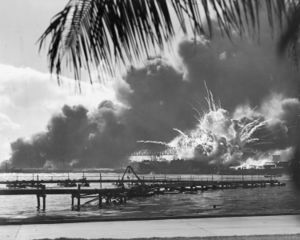
Puerto Rican immigration to Hawaiʻi began in 1899, when Puerto Rico's sugar industry was devastated by a hurricane, causing a worldwide shortage of sugar and a huge demand for sugar from Hawaiʻi. Hawaiian sugarcane plantation owners began to recruit experienced, unemployed laborers in Puerto Rico. Two waves of Korean immigration to Hawaiʻi occurred in the 20th century. The first wave arrived between 1903 and 1924; the second wave began in 1965 after President Lyndon B. Johnson signed the Immigration and Nationality Act of 1965, which removed racial and national barriers and resulted in significantly altering the demographic mix in the U.S.[133]
Oʻahu was the target of a surprise attack on Pearl Harbor by Imperial Japan on December 7, 1941. The attack on Pearl Harbor and other military and naval installations, carried out by aircraft and by midget submarines, brought the United States into World War II.
Political changes of 1954 – State of Hawaiʻi (1959–present)
وفي الستينات من القرن العشرين، ازداد عدد السكان في هاواي وازدهر اقتصادها، أما الصناعة فقد اشتد عودها وترعرعت في أواخر السبعينيات وأوائل الثمانينيات، كذلك ازدهرت الصناعة المسماة أقواكلنتر وهي تجارة تربية الحيوان وتنمية النباتات المائية. ولكي تقلل هاواي من اعتمادها على النفط، تطلعت إلى تطوير وتنمية مصادر بديلة للطاقة مثل الطاقة الشمسية، وقوة الرياح.
In the 1950s, the plantation owners' power was broken by the descendants of immigrant laborers, who were born in Hawaiʻi and were U.S. citizens. They voted against the Hawaiʻi Republican Party, strongly supported by plantation owners. The new majority voted for the Democratic Party of Hawaiʻi, which dominated territorial and state politics for more than 40 years. Eager to gain full representation in Congress and the Electoral College, residents actively campaigned for statehood. In Washington, there was talk that Hawaiʻi would be a Republican Party stronghold. As a result, the admission of Hawaii was matched with the admission of Alaska, which was seen as a Democratic Party stronghold. These predictions proved inaccurate; as of 2017, Hawaiʻi generally votes Democratic, while Alaska typically votes Republican.[134][135][136][137]
During the Cold War, Hawai'i became an important site for U.S. cultural diplomacy, military training, research, and as a staging ground for the U.S. war in Vietnam.[138]
In March 1959, Congress passed the Hawaiʻi Admissions Act, which U.S. President Dwight D. Eisenhower signed into law.[139] The act excluded Palmyra Atoll from statehood; it had been part of the Kingdom and Territory of Hawaiʻi. On June 27, 1959, a referendum asked residents of Hawaiʻi to vote on the statehood bill; 94.3% voted in favor of statehood and 5.7% opposed it.[140] The referendum asked voters to choose between accepting the Act and remaining a U.S. territory. The United Nations' Special Committee on Decolonization later removed Hawaiʻi from its list of non-self-governing territories.
After attaining statehood, Hawaiʻi quickly modernized through construction and a rapidly growing tourism economy. Later, state programs promoted Hawaiian culture.[which?] The Hawaiʻi State Constitutional Convention of 1978 created institutions such as the Office of Hawaiian Affairs to promote indigenous language and culture.[141]
Legacy of annexation on Hawaiian land
In 1897, over 21,000 Natives, representing the overwhelming majority of adult Hawaiians, signed anti-annexation petitions in one of the first examples of protest against the overthrow of Queen Liliʻuokalaniʻs government.[142] Nearly 100 years later, in 1993, 17,000 Hawaiians marched to demand access and control over Hawaiian trust lands and as part of the modern Hawaiian sovereignty movement.[143] Hawaiian trust land ownership and use is still widely contested as a consequence of annexation. According to scholar Winona LaDuke, as of 2015, 95% of Hawaiʻiʻs land was owned or controlled by just 82 landholders, including over 50% by federal and state governments, as well as the established sugar and pineapple companies.[143] The Thirty Meter Telescope is planned to be built on Hawaiian trust land, but has faced resistance as the project interferes with Kanaka indigeneity.[clarify][144]
المدن والبلدات

| التعداد تاريخياً | |||
|---|---|---|---|
| الإحصاء | التعداد | %± | |
| 1900 | 154٬001 | ||
| 1910 | 191٬874 | 24.6% | |
| 1920 | 255٬881 | 33.4% | |
| 1930 | 368٬300 | 43.9% | |
| 1940 | 422٬770 | 14.8% | |
| 1950 | 499٬794 | 18.2% | |
| 1960 | 632٬772 | 26.6% | |
| 1970 | 769٬913 | 21.7% | |
| 1980 | 964٬691 | 25.3% | |
| 1990 | 1٬108٬229 | 14.9% | |
| 2000 | 1٬211٬537 | 9.3% | |
| تقديري 2008[145] | 1٬288٬198 | 6.3% | |
الديموغرافيا
السكان
العرقيات
المجموعات الأصلية
| الأصل | النسبة المئوية | المقال الرئيسي: |
|---|---|---|
| (16.7%) من الإجمالي | انظر أمريكان يابانيون | |
| (16%) | انظر Native Hawaiians | |
| (14.1%) | انظر أمريكان فلبينيون | |
| (5.8%) | انظر أمريكان ألمان | |
| (4.7%) | انظر أمريكان صينيون | |
| (4.4%) | انظر أمريكان أيرلنديون | |
| (4.3%) | انظر أمريكان إنجليز | |
| (4.0%) | انظر أمريكان برتغاليون | |
| (2.5%) | See Puerto Rican | |
| (1.9%) | انظر أمريكان كوريون | |
| أفارقة | (1.8%) | انظر أمريكان أفارقة |
| (1.8%) | انظر أمريكان إيطاليون | |
| (1.6%) | انظر أمريكان مكسيكيون | |
| (1.5%) | انظر أمريكان فرنسيون | |
| (1.4%) | انظر أمريكان بريطانيون | |
| (1.1%) | انظر أمريكان اسكتلنديون |
اللغات
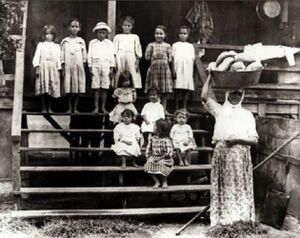
English and Hawaiian are listed as Hawaii's official languages in the state's 1978 constitution, in Article XV, Section 4.[147] However, the use of Hawaiian is limited because the constitution specifies that "Hawaiian shall be required for public acts and transactions only as provided by law". Hawaiʻi Creole English, locally referred to as "Pidgin", is the native language of many native residents and is a second language for many others.[148]
As of the 2000 Census, 73.4% of Hawaii residents age 5 and older exclusively speak English at home.[149] According to the 2008 American Community Survey, 74.6% of Hawaii's residents older than 5 speak only English at home.[150] In their homes, 21.0% of state residents speak an additional Asian language, 2.6% speak Spanish, 1.6% speak other Indo-European languages and 0.2% speak another language.[150]
After English, other languages popularly spoken in the state are Tagalog, Ilocano, and Japanese.[151] 5.4% of residents speak Tagalog, which includes non-native speakers of Filipino, a Tagalog-based national and co-official language of the Philippines; 5.0% speak Japanese and 4.0% speak Ilocano; 1.2% speak Chinese, 1.7% speak Hawaiian; 1.7% speak Spanish; 1.6% speak Korean; and 1.0% speak Samoan.[149]
Hawaiian
The Hawaiian language has about 2,000 native speakers, about 0.15% of the total population.[152] According to the United States Census, there were more than 24,000 total speakers of the language in Hawaii in 2006–2008.[153] Hawaiian is a Polynesian member of the Austronesian language family.[152] It is closely related to other Polynesian languages, such as Marquesan, Tahitian, Māori, Rapa Nui (the language of Easter Island), and less closely to Samoan and Tongan.[154]
According to Schütz, the Marquesans colonized the archipelago in roughly 300 CE[155] and were later followed by waves of seafarers from the Society Islands, Samoa and Tonga.[156] These Polynesians remained in the islands; they eventually became the Hawaiian people and their languages evolved into the Hawaiian language.[157] Kimura and Wilson say: "[l]inguists agree that Hawaiian is closely related to Eastern Polynesian, with a particularly strong link in the Southern Marquesas, and a secondary link in Tahiti, which may be explained by voyaging between the Hawaiian and Society Islands".[158]
Before the arrival of Captain James Cook, the Hawaiian language had no written form. That form was developed mainly by American Protestant missionaries between 1820 and 1826 who assigned to the Hawaiian phonemes letters from the Latin alphabet. Interest in Hawaiian increased significantly in the late 20th century. With the help of the Office of Hawaiian Affairs, specially designated immersion schools in which all subjects would be taught in Hawaiian were established. The University of Hawaiʻi developed a Hawaiian-language graduate studies program. Municipal codes were altered to favor Hawaiian place and street names for new civic developments.[159]
Hawaiian distinguishes between long and short vowel sounds. In modern practice, vowel length is indicated with a macron (kahakō). Hawaiian-language newspapers (nūpepa) published from 1834 to 1948 and traditional native speakers of Hawaiian generally omit the marks in their own writing. The ʻokina and kahakō are intended to capture the proper pronunciation of Hawaiian words.[160] The Hawaiian language uses the glottal stop (ʻOkina) as a consonant. It is written as a symbol similar to the apostrophe or left-hanging (opening) single quotation mark.[161]
The keyboard layout used for Hawaiian is QWERTY.[162]
Hawaiian Pidgin
هذا القسم يحتاج المزيد من الأسانيد للتحقق. (June 2021) (Learn how and when to remove this template message) |
Some residents of Hawaii speak Hawaiʻi Creole English (HCE), endonymically called pidgin or pidgin English. The lexicon of HCE derives mainly from English but also uses words that have derived from Hawaiian, Chinese, Japanese, Portuguese, Ilocano and Tagalog. During the 19th century, the increase in immigration—mainly from China, Japan, Portugal—especially from the Azores and Madeira, and Spain—catalyzed the development of a hybrid variant of English known to its speakers as pidgin. By the early 20th century, pidgin speakers had children who acquired it as their first language. HCE speakers use some Hawaiian words without those words being considered archaic.[مطلوب توضيح] Most place names are retained from Hawaiian, as are some names for plants and animals. For example, tuna fish is often called by its Hawaiian name, ahi.[163]
HCE speakers have modified the meanings of some English words. For example, "aunty" and "uncle" may either refer to any adult who is a friend or be used to show respect to an elder. Syntax and grammar follow distinctive rules different from those of General American English. For example, instead of "it is hot today, isn't it?", an HCE speaker would say simply "stay hot, eh?"[خ] The term da kine is used as a filler; a substitute for virtually any word or phrase. During the surfing boom in Hawaii, HCE was influenced by surfer slang. Some HCE expressions, such as brah and da kine, have found their ways elsewhere through surfing communities.[164]
Hawaiʻi Sign Language
Hawaiʻi Sign Language, a sign language for the Deaf based on the Hawaiian language, has been in use in the islands since the early 1800s. It is dwindling in numbers due to American Sign Language supplanting HSL through schooling and various other domains.[165]
الدين
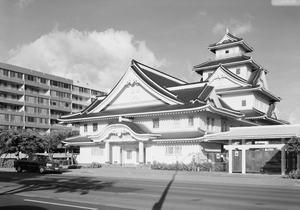
Religious self-identification, per Public Religion Research Institute's 2022 American Values Survey[166]
Religion in Hawaii (2014)[167]
Hawaii is among the most religiously diverse states in the U.S., with one in ten residents practicing a non-Christian faith.[168] Roughly one-quarter to half the population identify as unaffiliated and nonreligious, making Hawaii one of the most secular states as well.
Christianity remains the majority religion, represented mainly by various Protestant groups and Roman Catholicism. The second-largest religion is Buddhism, which comprises a larger proportion of the population than in any other state; it is concentrated in the Japanese community. Native Hawaiians continue to engage in traditional religious and spiritual practices today, often adhering to Christian and traditional beliefs at the same time.[46][93][91][75][92]
The Cathedral Church of Saint Andrew in Honolulu was formally the seat of the Hawaiian Reformed Catholic Church, a province of the Anglican Communion that had been the state church of the Kingdom of Hawaii; it subsequently merged into the Episcopal Church in the 1890s following the overthrow of the Kingdom of Hawaii, becoming the seat of the Episcopal Diocese of Hawaii. The Cathedral Basilica of Our Lady of Peace and the Co-Cathedral of Saint Theresa of the Child Jesus serve as seats of the Roman Catholic Diocese of Honolulu. The Eastern Orthodox community is centered around the Saints Constantine and Helen Greek Orthodox Cathedral of the Pacific.
The largest religious denominations by membership were the Roman Catholic Church with 249,619 adherents in 2010;[169] the Church of Jesus Christ of Latter-day Saints with 68,128 adherents in 2009;[170] the United Church of Christ with 115 congregations and 20,000 members; and the Southern Baptist Convention with 108 congregations and 18,000 members.[171] Nondenominational churches collectively have 128 congregations and 32,000 members.
According to data provided by religious establishments, religion in Hawaii in 2000 was distributed as follows:[172][173]
- Christianity: 351,000 (29%)
- Buddhism: 110,000 (9%)
- Judaism: 10,000 (1%)[174]
- Other: 100,000 (10%)
- Unaffiliated: 650,000 (51%)
However, a Pew poll found that the religious composition was as follows:
| Affiliation | % of Hawaiʻi's population | |
|---|---|---|
| Christian | 63 | |
| Protestant | 38 | |
| Evangelical Protestant | 25 | |
| Mainline Protestant | 11 | |
| Black church | 2 | |
| Roman Catholic | 20 | |
| Mormon | 3 | |
| Jehovah's Witnesses | 1 | |
| Eastern Orthodox | 0.5 | |
| Other Christian | 1 | |
| Unaffiliated | 26 | |
| Nothing in particular | 20 | |
| Agnostic | 5 | |
| Atheist | 2 | |
| Non-Christian faiths | 10 | |
| Jewish | 0.5 | |
| Muslim | 0.5 | |
| Buddhist | 8 | |
| Hindu | 0.5 | |
| Other Non-Christian faiths | 0.5 | |
| Don't know | 1 | |
| Total | 100 | |
الإقتصاد
The history of Hawaii's economy can be traced through a succession of dominant industries: sandalwood,[175] whaling,[176] sugarcane, pineapple, the military, tourism and education. By the 1840s, sugar plantations had gained a strong foothold in the Hawaiian economy, due to a high demand of sugar in the United States and rapid transport via steamships.[62] Sugarcane plantations were tightly controlled by American missionary families and businessmen known as "the Big Five", who monopolized control of the sugar industry's profits.[62][63] By the time Hawaiian annexation was being considered in 1898, sugarcane producers turned to cultivating tropical fruits like pineapple, which became the principal export for Hawaiʻi's plantation economy.[63][62] Since statehood in 1959, tourism has been the largest industry, contributing 24.3% of the gross state product (GSP) in 1997, despite efforts to diversify. The state's gross output for 2003 was US$47 billion; per capita income for Hawaii residents in 2014 was US$54٬516.[177] Hawaiian exports include food and clothing. These industries play a small role in the Hawaiian economy, due to the shipping distance to viable markets, such as the West Coast of the United States. The state's food exports include coffee, macadamia nuts, pineapple, livestock, sugarcane and honey.[178]
By weight, honey bees may be the state's most valuable export.[179] According to the Hawaii Agricultural Statistics Service, agricultural sales were US$370٫9 million from diversified agriculture, US$100٫6 million from pineapple, and US$64٫3 million from sugarcane. Hawaii's relatively consistent climate has attracted the seed industry, which is able to test three generations of crops per year on the islands, compared with one or two on the mainland.[180] Seeds yielded US$264 million in 2012, supporting 1,400 workers.[181]
اعتبارا من ديسمبر 2015[تحديث], the state's unemployment rate was 3.2%.[182] In 2009, the United States military spent US$12٫2 billion in Hawaii, accounting for 18% of spending in the state for that year. 75,000 United States Department of Defense personnel live in Hawaii.[183] According to a 2013 study by Phoenix Marketing International, Hawaii at that time had the fourth-largest number of millionaires per capita in the United States, with a ratio of 7.2%.[184]
الصناعات الخدمية تسهم بما يقرب من 30% من الناتج الوطني الإجمالي في ولاية هاواي في العام. ولا يوجد بين أي من الولايات المتحدة الأخرى، ولاية تعتمد في دخلها على هذا الكم الهائل من الصناعات الخدمية. كما أن الأنشطة السياحية والعسكرية تسهم إسهاماً كبيرًا في الدخل الناتج عن الصناعات الخدمية. كذلك فإن الأنشطة الحكومية تفسر وجود مزيد من الإنتاج الإجمالي الضخم في هاواي، أكثر مما يقدمه أي نشاط اقتصادي مفرد. يدير جيش الولايات المتحدة، وسلاح الطيران والبحرية، القواعد في جزيرة أواهو،كما أن خدمات الجمهور، اجتماعيًا وشخصيًا، تشكل الصناعات الخدمية من الدرجة الثانية في هاواي، وتشمل الفنادق والرعاية الصحية.
وتوظف تجارة الجملة وتجارة التجزئة عدداً من العمال أكثر من أي صناعة أخرى في هاواي. وتجارة التجزئة تحظى بدخل كبير من السياح، كما أن تجارة الجملة في عالم البقالة، والمنتجات البترولية،لها أهميتها في جزر هاواي.كذلك فإن الطلب على العقارات يشكل نشاطاً كبيرًا في تلك الجزر، وقد ازدادت قيمة العقارات في هاواي بشكل منتظم نظرًا للنمو المطرد في عدد السكان في مساحة صغيرة من الأرض. وتعليب المواد الغذائية يعد النشاط الصناعي الأول في هاواي، فالسكر المكرر والأناناس المعلب، هما أهم المنتجات الغذائية،كما أن المزارعين في هاواي يزرعون في الأغلب الأعم كل الأناناس ونحو ثلث إنتاج قصب السكر في الولايات المتحدة برمتها.
وتصدر ولاية هاواي مقادير هائلة من الزهور وأكاليل الزهر ليس. ومدينة هيلو هي مركز زراعة الورود وتعبئتها. وكثير من تلك الجزر تزرع نوعا من المكسرات المسمى جوز الماكاداميا. ويعد النقل من المشكلات الرئيسية في جزر هاواي، ونظراً لقلة الصناعات في تلك الولاية، فإن أكثر البضائع يجب أن يشحن بطريق الجو أو البحر، إما من المركز الرئيسي في هاواي ذاتها، وإما من بعض الدول الأجنبية. وهذا الوضع يرفع تكلفة أكثرالسلع في هاواي كما أن السفر في داخل الولاية باهظ التكاليف؛ لأن الجزر متفرقة ومتباعدة عن بعضها بعضًا.
والخطوط الجوية هي أسرع وأيسر وسيلة للسفر. وتضم الموانئ الرئيسية في تلك الجزر: هونولولو الواقعة على جزيرة أواهو، وتضم كذلك هيلو وكاوايهاي في هاواي، وناويليو ويلي، وبورت ألين في كاواي، كما تضم كاهولوي في جزيرة ماوي.
Cost of living
The cost of living in Hawaii, specifically Honolulu, is high compared to that of most major U.S. cities, although it is 6.7% lower than in New York City and 3.6% lower than in San Francisco.[185] These numbers may not take into account some costs, such as increased travel costs for flights, additional shipping fees, and the loss of promotional participation opportunities for customers outside the contiguous U.S. While some online stores offer free shipping on orders to Hawaii, many merchants exclude Hawaii, Alaska, Puerto Rico and certain other U.S. territories.[186][187]
Hawaiian Electric Industries, a privately owned company, provides 95% of the state's population with electricity, mostly from fossil-fuel power stations. Average electricity prices in October 2014 (36.41 سنت لكل كيلوواط ساعة) were nearly three times the national average (12.58 سنت لكل كيلوواط ساعة) and 80% higher than the second-highest state, Connecticut.[188]
The median home value in Hawaii in the 2000 U.S. Census was US$272٬700, while the national median home value was US$119٬600. Hawaii home values were the highest of all states, including California with a median home value of US$211٬500.[189] Research from the National Association of Realtors places the 2010 median sale price of a single family home in Honolulu, Hawaii, at US$607٬600 and the U.S. median sales price at US$173٬200. The sale price of single family homes in Hawaii was the highest of any U.S. city in 2010, just above that of the Silicon Valley area of California (US$602٬000).[190]
Hawaii's very high cost of living is the result of several interwoven factors of the global economy in addition to domestic U.S. government trade policy. Like other regions with desirable weather year-round, such as California, Arizona and Florida, Hawaii's residents can be considered to be subject to a "sunshine tax". This situation is further exacerbated by the natural factors of geography and world distribution that lead to higher prices for goods due to increased shipping costs, a problem which many island states and territories suffer from as well.
The higher costs to ship goods across an ocean may be further increased by the requirements of the Jones Act, which generally requires that goods be transported between places within the U.S., including between the mainland U.S. west coast and Hawaii, using only U.S.-owned, built, and crewed ships. Jones Act-compliant vessels are often more expensive to build and operate than foreign equivalents, which can drive up shipping costs. While the Jones Act does not affect transportation of goods to Hawaii directly from Asia, this type of trade is nonetheless not common; this is a result of other primarily economic reasons including additional costs associated with stopping over in Hawaii (e.g. pilot and port fees), the market size of Hawaii, and the economics of using ever-larger ships that cannot be handled in Hawaii for transoceanic voyages. Therefore, Hawaii relies on receiving most inbound goods on Jones Act-qualified vessels originating from the U.S. west coast, which may contribute to the increased cost of some consumer goods and therefore the overall cost of living.[191][192] Critics of the Jones Act contend that Hawaii consumers ultimately bear the expense of transporting goods imposed by the Jones Act.[193]
الثقافة
The aboriginal culture of Hawaii is Polynesian. Hawaii represents the northernmost extension of the vast Polynesian Triangle of the south and central Pacific Ocean. While traditional Hawaiian culture remains as vestiges in modern Hawaiian society, there are re-enactments of the ceremonies and traditions throughout the islands. Some of these cultural influences, including the popularity (in greatly modified form) of lūʻau and hula, are strong enough to affect the wider United States.
Cuisine
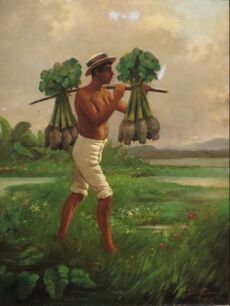
The cuisine of Hawaii is a fusion of many foods brought by immigrants to the Hawaiian Islands, including the earliest Polynesians and Native Hawaiian cuisine, and American, Chinese, Filipino, Japanese, Korean, Polynesian, Puerto Rican, and Portuguese origins. Plant and animal food sources are imported from around the world for agricultural use in Hawaii. Poi, a starch made by pounding taro, is one of the traditional foods of the islands. Many local restaurants serve the ubiquitous plate lunch, which features two scoops of rice, a simplified version of American macaroni salad and a variety of toppings including hamburger patties, a fried egg, and gravy of a loco moco, Japanese style tonkatsu or the traditional lūʻau favorites, including kālua pork and laulau. Spam musubi is an example of the fusion of ethnic cuisine that developed on the islands among the mix of immigrant groups and military personnel. In the 1990s, a group of chefs developed Hawaii regional cuisine as a contemporary fusion cuisine.
Customs and etiquette
Some key customs and etiquette in Hawaii are as follows: when visiting a home, it is considered good manners to bring a small gift for one's host (for example, a dessert). Thus, parties are usually in the form of potlucks. Most locals take their shoes off before entering a home. It is customary for Hawaiian families, regardless of ethnicity, to hold a luau to celebrate a child's first birthday. It is also customary at Hawaiian weddings, especially at Filipino weddings, for the bride and groom to do a money dance (also called the pandanggo). Print media and local residents recommend that one refer to non-Hawaiians as "locals of Hawaii" or "people of Hawaii".
Hawaiian mythology
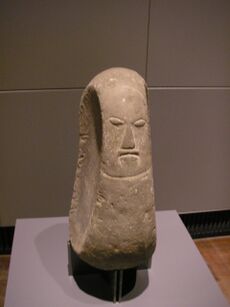
Hawaiian mythology includes the legends, historical tales, and sayings of the ancient Hawaiian people. It is considered a variant of a more general Polynesian mythology that developed a unique character for several centuries before ح. 1800. It is associated with the Hawaiian religion, which was officially suppressed in the 19th century but was kept alive by some practitioners to the modern day.[194] Prominent figures and terms include Aumakua, the spirit of an ancestor or family god and Kāne, the highest of the four major Hawaiian deities.[بحاجة لمصدر]
Polynesian mythology
Polynesian mythology is the oral traditions of the people of Polynesia, a grouping of Central and South Pacific Ocean island archipelagos in the Polynesian triangle together with the scattered cultures known as the Polynesian outliers. Polynesians speak languages that descend from a language reconstructed as Proto-Polynesian that was probably spoken in the area around Tonga and Samoa in around 1000 BC.[195]
Prior to the 15th century, Polynesian people migrated east to the Cook Islands, and from there to other island groups such as Tahiti and the Marquesas. Their descendants later discovered the islands Tahiti, Rapa Nui, and later the Hawaiian Islands and New Zealand.[196]
The Polynesian languages are part of the Austronesian language family. Many are close enough in terms of vocabulary and grammar to be mutually intelligible. There are also substantial cultural similarities between the various groups, especially in terms of social organization, childrearing, horticulture, building and textile technologies. Their mythologies in particular demonstrate local reworkings of commonly shared tales. The Polynesian cultures each have distinct but related oral traditions; legends or myths are traditionally considered to recount ancient history (the time of "pō") and the adventures of gods ("atua") and deified ancestors.[بحاجة لمصدر]
List of state parks
There are many Hawaiian state parks.
- The Island of Hawaiʻi has state parks, recreation areas, and historical parks.
- Kauaʻi has the Ahukini State Recreation Pier, six state parks, and the Russian Fort Elizabeth State Historical Park.
- Maui has two state monuments, several state parks, and the Polipoli Spring State Recreation Area. Moloka'i has the Pala'au State Park.
- Oʻahu has several state parks, a number of state recreation areas, and a number of monuments, including the Ulu Pō Heiau State Monument.
Literature
The literature of Hawaii is diverse and includes authors Kiana Davenport, Lois-Ann Yamanaka, and Kaui Hart Hemmings. Hawaiian magazines include Hana Hou!, Hawaii Business and Honolulu, among others.
Music

The music of Hawaii includes traditional and popular styles, ranging from native Hawaiian folk music to modern rock and hip hop.
Styles such as slack-key guitar are well known worldwide, while Hawaiian-tinged music is a frequent part of Hollywood soundtracks. Hawaii also made a major contribution to country music with the introduction of the steel guitar.[197]
Traditional Hawaiian folk music is a major part of the state's musical heritage. The Hawaiian people have inhabited the islands for centuries and have retained much of their traditional musical knowledge. Their music is largely religious in nature, and includes chanting and dance music.
Hawaiian music has had an enormous impact on the music of other Polynesian islands; according to Peter Manuel, the influence of Hawaiian music is a "unifying factor in the development of modern Pacific musics".[198] Native Hawaiian musician and Hawaiian sovereignty activist Israel Kamakawiwoʻole, famous for his medley of "Somewhere Over the Rainbow/What a Wonderful World", was named "The Voice of Hawaii" by NPR in 2010 in its 50 great voices series.[199]
Sports
Due to its distance from the continental United States, team sports in Hawaii are characterised by youth, collegial and amateur teams over professional teams, although some professional teams sports teams have at one time played in the state. Notable professional teams include The Hawaiians, which played at the World Football League in 1974 and 1975; the Hawaii Islanders, a Triple-A minor league baseball team that played at the Pacific Coast League from 1961 to 1987; and Team Hawaii, a North American Soccer League team that played in 1977.
Notable college sports events in Hawaii include the Maui Invitational Tournament, Diamond Head Classic (basketball) and Hawaii Bowl (football). The only NCAA Division I team in Hawaii is the Hawaii Rainbow Warriors and Rainbow Wahine, which competes at the Big West Conference (major sports), Mountain West Conference (football) and Mountain Pacific Sports Federation (minor sports). There are three teams in NCAA Division II: Chaminade Silverswords, Hawaii Pacific Sharks and Hawaii-Hilo Vulcans, all of which compete at the Pacific West Conference.
Surfing has been a central part of Polynesian culture for centuries. Since the late 19th century, Hawaii has become a major site for surfists from around the world. Notable competitions include the Triple Crown of Surfing and The Eddie. Likewise, Hawaii has produced elite-level swimmers, including five-time Olympic medalist Duke Kahanamoku and Buster Crabbe, who set 16 swimming world records.
Hawaii has hosted the Sony Open in Hawaii golf tournament since 1965, the Tournament of Champions golf tournament since 1999, the Lotte Championship golf tournament since 2012, the Honolulu Marathon since 1973, the Ironman World Championship triathlon race since 1978, the Ultraman triathlon since 1983, the National Football League's Pro Bowl from 1980 to 2016, the 2000 FINA World Open Water Swimming Championships, and the 2008 Pan-Pacific Championship and 2012 Hawaiian Islands Invitational soccer tournaments.
Hawaii has produced a number of notable Mixed Martial Arts fighters, such as former UFC Lightweight Champion and UFC Welterweight Champion B.J. Penn, and former UFC Featherweight Champion Max Holloway. Other notable Hawaiian Martial Artists include Travis Browne, K. J. Noons, Brad Tavares and Wesley Correira.
Hawaiians have found success in the world of sumo wrestling. Takamiyama Daigorō was the first foreigner to ever win a sumo title in Japan, while his protege Akebono Tarō became a top-level sumo wrestler in Japan during the 1990s before transitioning into a successful professional wrestling career in the 2000s. Akebono was the first foreign-born Sumo to reach Yokozuna in history and helped fuel a boom in interest in Sumo during his career.
الصحة
اعتبارا من 2009[تحديث], Hawaii's health care system insures 92% of residents. Under the state's plan, businesses are required to provide insurance to employees who work more than twenty hours per week. Heavy regulation of insurance companies helps reduce the cost to employers. Due in part to heavy emphasis on preventive care, Hawaiians require hospital treatment less frequently than the rest of the United States, while total health care expenses measured as a percentage of state GDP are substantially lower.[بحاجة لمصدر] Proponents of universal health care elsewhere in the U.S. sometimes use Hawaii as a model for proposed federal and state health care plans.[بحاجة لمصدر]
التعليم
المدارس والأكاديميات
الكليات والجامعات
الحوكمة
Political subdivisions and local government
The movement of the Hawaiian royal family from Hawaiʻi Island to Maui, and subsequently to Oʻahu, explains the modern-day distribution of population centers. Kamehameha III chose the largest city, Honolulu, as his capital because of its natural harbor—the present-day Honolulu Harbor. Now the state capital, Honolulu is located along the southeast coast of Oʻahu. The previous capital was Lahaina, Maui, and before that Kailua-Kona, Hawaiʻi. Some major towns are Hilo; Kaneohe; Kailua; Pearl City; Waipahu; Kahului; Kailua-Kona. Kīhei; and Līhuʻe.
Hawaii has five counties: the City and County of Honolulu, Hawaii County, Maui County, Kauai County, and Kalawao County.
Hawaii has the fewest local governments among U.S. states.[200][201] Unique to this state is the lack of municipal governments. All local governments are generally administered at the county level. The only incorporated area in the state is Honolulu County, a consolidated city–county that governs the entire island of Oahu. County executives are referred to as mayors; these are the Mayor of Hawaii County, Mayor of Honolulu, Mayor of Kauaʻi, and the Mayor of Maui. The mayors are all elected in nonpartisan elections. Kalawao County has no elected government,[202] and as mentioned above there are no local school districts; instead, all local public education is administered at the state level by the Hawaii Department of Education. The remaining local governments are special districts.[200][201]
State government

The state government of Hawaii is modeled after the federal government with adaptations originating from the kingdom era of Hawaiian history. As codified in the Constitution of Hawaii, there are three branches of government: executive, legislative and judicial. The executive branch is led by the Governor of Hawaii, who is assisted by the Lieutenant Governor of Hawaii, both of whom are elected on the same ticket. The governor is the only state public official elected statewide; all others are appointed by the governor. The lieutenant governor acts as the Secretary of State. The governor and lieutenant governor oversee twenty agencies and departments from offices in the State Capitol. The official residence of the governor is Washington Place.
The legislative branch consists of the bicameral Hawaii State Legislature, which is composed of the 51-member Hawaii House of Representatives led by the Speaker of the House, and the 25-member Hawaii Senate led by the President of the Senate. The Legislature meets at the State Capitol. The unified judicial branch of Hawaii is the Hawaii State Judiciary. The state's highest court is the Supreme Court of Hawaii, which uses Aliʻiōlani Hale as its chambers.
Federal government
- Congressional delegation for the 118th United States Congress
Senator Brian Schatz
Senator Mazie Hirono
Representative Jill Tokuda (HI-2)
Hawaii is represented in the United States Congress by two senators and two representatives. اعتبارا من 2023[تحديث], all four seats are held by Democrats. Former representative Ed Case was elected in 2018 to the 1st congressional district. Jill Tokuda represents the 2nd congressional district, representing the rest of the state, which is largely rural and semi-rural.[203]
Brian Schatz is the senior United States senator from Hawaii. He was appointed to the office on December 26, 2012, by Governor Neil Abercrombie, following the death of former senator Daniel Inouye. Schatz then won the 2014 special election, and the 2016 and 2022 regular elections in Hawaii as Senator.
The state's junior senator is Mazie Hirono, the former representative from the second congressional district. She won in the 2012 and 2018 elections for Senator in Hawaii, following the retirement of Daniel Akaka. Hirono is the first female Asian American senator and the first Buddhist senator.
Hawaii incurred the biggest seniority shift between the 112th and 113th Congresses. The state went from a delegation consisting of senators who were first and twenty-first in seniority[د] to their respective replacements, relative newcomers Schatz and Hirono.[204]
Federal officials in Hawaii are based at the Prince Kūhiō Federal Building near the Aloha Tower and Honolulu Harbor. The Federal Bureau of Investigation, Internal Revenue Service and the Secret Service maintain their offices there; the building is also the site of the federal District Court for the District of Hawaii and the United States Attorney for the District of Hawaii.
السياسة
Since gaining statehood and participating in its first election in 1960, Hawaii has supported Democrats in all but two presidential elections: 1972 and 1984, both of which were landslide reelection victories for Republicans Richard Nixon and Ronald Reagan respectively. In Hawaii's statehood tenure, only Minnesota has supported Republican candidates fewer times in presidential elections. The 2022 Cook Partisan Voting Index ranks Hawaii as the third-most heavily Democratic state in the nation.[205]
Hawaii has not elected a Republican to represent the state in the U.S. Senate since Hiram Fong in 1970; since 1977, both of the state's U.S. Senators have been Democrats.[206][207]
In 2004, John Kerry won the state's four electoral votes by a margin of nine percentage points with 54% of the vote. Every county supported the Democratic candidate. In 1964, favorite son candidate senator Hiram Fong of Hawaii sought the Republican presidential nomination, while Patsy Mink ran in the Oregon primary in 1972.
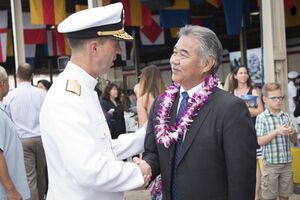
Honolulu-born Barack Obama, then serving as a United States senator from Illinois, was elected the 44th president of the United States on November 4, 2008, and was re-elected for a second term on November 6, 2012. Obama had won the Hawaii Democratic caucus on February 19, 2008, with 76% of the vote. He was the third Hawaii-born candidate to seek the nomination of a major party, the first presidential nominee and first president from Hawaii.[208][209]
In a 2020 study, Hawaii was ranked as the 6th easiest state for citizens to vote in.[210]
Law enforcement
Hawaii has a statewide sheriff department under its Department of Public Safety that provides law enforcement protection to government buildings and Daniel K. Inouye International Airport as well as correction services to all correctional facilities owned by the state.
Counties have their own respective police departments with their own jurisdictions:
- Kauai County Police Department for the island of Kauai
- Honolulu Police Department for Oahu
- Maui County Police Department for Molokai, Maui and Lanai
- Hawaii County Police Department for the Big Island
Forensic services for all agencies in the state are provided by the Honolulu Police Department.[211]
In January 2022, state officials proposed legislation that would split the sheriff department from the Department of Public Safety and consolidate it with the criminal investigation division from the Department of the Attorney General to create a new Department of Law Enforcement that would create a statewide police agency with the ability to investigate crimes.[212]
النقل
- انظر أيضا: وزارة النقل في هاواي.
الإعلام
حركة سيادة هاوائي
While Hawaii is internationally recognized as a state of the United States while also being broadly accepted as such in mainstream understanding, the legality of this status has been questioned in U.S. District Court,[213] the U.N., and other international forums.[214] Domestically, the debate is a topic covered in the Kamehameha Schools curriculum,[215] and in classes at the University of Hawaiʻi at Mānoa.[216]
Political organizations seeking some form of sovereignty for Hawaii have been active since the late 19th century. Generally, their focus is on self-determination and self-governance, either for Hawaii as an independent nation (in many proposals, for "Hawaiian nationals" descended from subjects of the Hawaiian Kingdom or declaring themselves as such by choice), or for people of whole or part native Hawaiian ancestry in an indigenous "nation to nation" relationship akin to tribal sovereignty with US federal recognition of Native Hawaiians. The pro-federal recognition Akaka Bill drew substantial opposition among Hawaiian residents in the 2000s.[217][218] Opponents to the tribal approach argue it is not a legitimate path to Hawaiian nationhood; they also argue that the U.S. government should not be involved in re-establishing Hawaiian sovereignty.[219][220]
The Hawaiian sovereignty movement views the overthrow of the Kingdom of Hawaii in 1893 as illegal, and views the subsequent annexation of Hawaii by the United States as illegal as well; the movement seeks some form of greater autonomy for Hawaii, such as free association or independence from the United States.[218][221][222][223][224]
Some groups also advocate some form of redress from the United States for the 1893 overthrow of Queen Liliʻuokalani, and for what is described as a prolonged military occupation beginning with the 1898 annexation. The Apology Resolution passed by US Congress in 1993 is cited as a major impetus by the movement for Hawaiian sovereignty.[221] The sovereignty movement considers Hawaii to be an illegally occupied nation.[222][225][226][220]
علاقات التآخي الدولية
 Ehime, Japan, 2003[227]
Ehime, Japan, 2003[227] Fukuoka, Japan, 1981[228]
Fukuoka, Japan, 1981[228] Hiroshima, Japan, 1997[229]
Hiroshima, Japan, 1997[229] Hokkaido, Japan, 2017[230]
Hokkaido, Japan, 2017[230] Okinawa, Japan, 1985[231]
Okinawa, Japan, 1985[231] Yamaguchi, Japan, 2022[232]
Yamaguchi, Japan, 2022[232] Guangdong, China, 1985[233]
Guangdong, China, 1985[233] Hainan, China, 1992[233]
Hainan, China, 1992[233] Jeju, South Korea, 1986[233]
Jeju, South Korea, 1986[233] Taiwan, Republic of China, 1993[233]
Taiwan, Republic of China, 1993[233] Cebu, Philippines, 1996[233]
Cebu, Philippines, 1996[233] Isabela, Philippines, 2006[233]
Isabela, Philippines, 2006[233] Pangasinan, Philippines, 2002[233]
Pangasinan, Philippines, 2002[233] Ilocos Sur, Philippines, 1985[233]
Ilocos Sur, Philippines, 1985[233] Ilocos Norte, Philippines, 2005[233]
Ilocos Norte, Philippines, 2005[233] Rabat-Salé-Zemmour-Zaër, Morocco, 2011[233]
Rabat-Salé-Zemmour-Zaër, Morocco, 2011[233] Azores Islands, Portugal, 1982[233]
Azores Islands, Portugal, 1982[233] Bali, Indonesia, 2014[233]
Bali, Indonesia, 2014[233] Goa, India, 2018[233]
Goa, India, 2018[233]
انظر أيضا
- Index of Hawaii-related articles
- List of cemeteries in Hawaii
- Outline of Hawaii
- USS Hawaii, two ships
المصادر
- ^ Brodie, Carolyn S; Goodrich, Debra; Montgomery, Paula Kay (1996). The Bookmark Book. Englewood, CO: Libraries Unlimited. ISBN 9781563083006. OCLC 34164045. Retrieved August 5, 2015.
- ^ "Play Ball holds unforgettable 1st event in Hawaii". MLB.com. Archived from the original on November 19, 2019. Retrieved April 6, 2020.
- ^ Hawaii State Legislature. "Haw. Rev. Stat. § 5–9 (State motto)". Archived from the original on October 15, 2015. Retrieved December 9, 2013.
- ^ Hawaii State Legislature. "Haw. Rev. Stat. § 5–10 (State song)". Archived from the original on January 16, 2003. Retrieved December 9, 2013.
- ^ "Summit USGS 1977". NGS data sheet. U.S. National Geodetic Survey.
- ^ أ ب "Elevations and Distances in the United States". United States Geological Survey. 2001. Archived from the original on October 15, 2011. Retrieved October 21, 2011.
- ^ "US Census Bureau QuickFacts: Hawaii". US Census Bureau. Retrieved May 9, 2022.
- ^ "Style Manual; An official guide to the form and style of Federal Government publishing" (PDF). United States Government Publishing Office. 2016. Archived (PDF) from the original on July 29, 2018. Retrieved April 27, 2020.
- ^ قالب:Cite Merriam-Webster
- ^ "Is Hawaii a Part of Oceania or North America?". WorldAtlas. January 12, 2018. Archived from the original on July 11, 2019. Retrieved June 24, 2019.
- ^ أ ب "Top 5 richest states in the US". www.worldfinance.com. Archived from the original on November 27, 2020. Retrieved December 15, 2020.
- ^ Arias, Elizabeth (August 23, 2022). "National Vital Statistics Reports" (PDF). CDC.gov. Retrieved February 20, 2023.
- ^ Cartwright, Bruce (1929). "The Legend of Hawaii-loa" (PDF). Journal of the Polynesian Society. 38: 105–121. Archived from the original (PDF) on July 13, 2007 – via Ethnomathematics Digital Library (EDL).
- ^ "Origins of Hawaii's Names". Archived from the original on December 30, 2006. Retrieved February 24, 2007.
- ^ Biggs, Bruce (1994). "Does Māori have a closest relative?". In Sutton, Douglas G. (ed.). The Origins of the First New Zealanders. Auckland, NZ: Auckland University Press. pp. 96–105. ISBN 978-1-86940-098-9.
Clark, Ross (1994). "Moriori and Māori: The Linguistic Evidence". In Sutton, Douglas G. (ed.). The Origins of the First New Zealanders. Auckland, NZ: Auckland University Press. pp. 123–135. ISBN 978-1-86940-098-9. - ^ Pukui, M.K.; Elbert, S.H. (1986). Hawaiian Dictionary. Honolulu, HI: University of Hawaiʻi Press. p. 62. ISBN 978-0-8248-0703-0.
- ^ Pukui, M.K.; Elbert, S.H.; Mookini, E.T. (1974). Place Names of Hawaii. Honolulu, HI: University of Hawaiʻi Press. ISBN 978-0-8248-0208-0.
- ^ "Article XV, Section 4". The Constitution of the State of Hawaii. Hawaii Legislative Reference Bureau. Archived from the original on November 1, 2017. Retrieved March 18, 2015.
- ^ "Article XV, Section 1". The Constitution of the State of Hawaii. Hawaii Legislative Reference Bureau. Archived from the original on November 1, 2017. Retrieved March 18, 2015.
- ^ "The Constitution of the State of Hawaii". Hawaii Legislative Reference Bureau. Archived from the original on March 9, 2015. Retrieved March 18, 2015.
- ^ "Hawaiian language". Wow Polynesia. December 2, 2009. Archived from the original on June 18, 2011. Retrieved April 16, 2011.
- ^ [1]
- ^ U.S. Geological Survey Geographic Names Information System: Island of Hawaiʻi
- ^ U.S. Geological Survey Geographic Names Information System: Kauaʻi Island
- ^ U.S. Geological Survey Geographic Names Information System: Kahoʻolawe Island
- ^ U.S. Geological Survey Geographic Names Information System: Lānaʻi Island
- ^ U.S. Geological Survey Geographic Names Information System: Maui Island
- ^ U.S. Geological Survey Geographic Names Information System: Molokaʻi Island
- ^ U.S. Geological Survey Geographic Names Information System: Niʻihau Island
- ^ U.S. Geological Survey Geographic Names Information System: Oʻahu Island
- ^ "What constitutes the United States, what are the official definitions?". United States Geological Survey. Archived from the original on November 16, 2017. Retrieved July 3, 2007.
- ^ Rubin, Ken. "General Information about Hawaiian Shield Volcanoes". Archived from the original on December 29, 2010. Retrieved December 1, 2009.
- ^ "Mauna Kea Volcano, Hawaii". Hvo.wr.usgs.gov. Archived from the original on October 21, 2006. Retrieved November 5, 2011.
- ^ Unke, Beata (2001). "Height of the Tallest Mountain on Earth". The Physics Factbook. Archived from the original on August 19, 2007. Retrieved August 3, 2007.
- ^ "Youngest lava flows on East Maui probably older than A.D. 1790". United States Geological Survey. September 9, 1999. Archived from the original on February 22, 2001. Retrieved May 5, 2015.
- ^ "Living on Active Volcanoes—The Island of Hawaii, U.S. Geological Survey Fact Sheet 074-97". U.S. Geological Survey. Archived from the original on October 25, 2011. Retrieved November 5, 2011.
- ^ Swanson, D.A.; Rausch, J. (2008). "Human Footprints in Relation to the 1790 Eruption of Kīlauea". American Geophysical Union, Fall Meeting. 11: V11B–2022. Bibcode:2008AGUFM.V11B2022S.
- ^ "Largest islands of the world". Worldatlas.com. Archived from the original on March 21, 2011. Retrieved April 16, 2011.
- ^ Pacific Tsunami Warning Center (November 12, 2009). "Tsunami Safety & Preparedness in Hawaii". Archived from the original on March 7, 2011. Retrieved November 12, 2009.
- ^ Le Bas, T.P. (2007). "Slope Failures on the Flanks of Southern Cape Verde Islands". In Lykousis, Vasilios (ed.). Submarine mass movements and their consequences: 3rd international symposium. Springer Science+Business Media. ISBN 978-1-4020-6511-8.
- ^ Mitchell, N. (2003). "Susceptibility of mid-ocean ridge volcanic islands and seamounts to large scale landsliding". Journal of Geophysical Research. 108 (B8): 1–23. Bibcode:2003JGRB..108.2397M. doi:10.1029/2002jb001997. S2CID 131282494.
- ^ "Man Whose Leg Was Shattered By Hawaii's Volcano Eruption Speaks Out". May 24, 2018. Archived from the original on June 1, 2018. Retrieved May 31, 2018.
- ^ Howard Youth. "Hawaii's Forest Birds Sing the Blues". Archived from the original on March 18, 2007. Retrieved October 31, 2008.
- ^ "Hawaiian Native Plant Propagation Database". Archived from the original on November 28, 2014. Retrieved December 15, 2013.
- ^ Stephen Buchmann; Gary Paul Nabhan (June 22, 2012). The Forgotten Pollinators. Island Press. ISBN 9781597269087. Retrieved December 17, 2013.
- ^ أ ب ت ث LaDuke, Winona (1999). All our relations : native struggles for land and life. Cambridge, MA: South End Press. ISBN 0-89608-600-3. OCLC 41572567.
- ^ Fletcher, Charles H.; Murray-Wallace, Colin V.; Glenn, Craig R.; Sherman, Clark E.; Popp, Brian; Hessler, Angela (2005). "Age and Origin of Late Quaternary Eolianite, Kaiehu Point (Moomomi), Molokai, Hawaii". Journal of Coastal Research: 97–112. JSTOR 25736978.
- ^ Bates, Thomas F. (1962). "Halloysite and Gibbsite Formation in Hawaii". Clays and Clay Minerals. pp. 315–328. doi:10.1016/B978-1-4831-9842-2.50022-5. ISBN 978-1-4831-9842-2.
- ^ Macdonald, Gordon A.; Davis, Dan A.; Cox, Doak C. (May 27, 1960). "Geology and ground-water resources of the island of Kauai, Hawaii". Hawaii Division of Hydrography Bulletin. 13 – via pubs.er.usgs.gov.
- ^ "Hawaii". National Park Service. Archived from the original on July 3, 2008. Retrieved July 15, 2008.
- ^ Joshua Reichert and Theodore Roosevelt IV (June 15, 2006). "Treasure Islands". Archived from the original on September 30, 2006.
- ^ "Honolulu, HI Weather History: June 24, 2022". wunderground.com.
- ^ "Climate of Hawaii". Prh.noaa.gov. Archived from the original on November 1, 2011. Retrieved November 5, 2011.
- ^ "Less & Heavy Rain". State of Hawaii. Retrieved June 11, 2023.
- ^ "Rising temperatures". State of Hawaii. Retrieved June 11, 2023.
- ^ أ ب "State Climate Extremes Committee (SCEC)". US National Oceanographic and Atmospheric Administration (NOAA), National Centers for Environmental Information. Archived from the original on February 21, 2018. Retrieved February 2, 2017.
- ^ "Climate of Hawaii". Western Regional Climate Center. Retrieved 26 June 2022.
- ^ أ ب ت Takumi, Roy (1994). "Challenging U.S. Militarism in Hawai'i and Okinawa". Race, Poverty & the Environment. 4/5 (4/1): 8–9. ISSN 1532-2874. JSTOR 41555279.
- ^ Blackford, Mansel G. (2004-09-01). "Environmental Justice, Native Rights, Tourism, and Opposition to Military Control: The Case of Kaho'olawe". Journal of American History. 91 (2): 544–571. doi:10.2307/3660711. ISSN 0021-8723. JSTOR 3660711.
- ^ LaDuke, Winona (2017). All our relations : Native struggles for land and life. Chicago. p. 173. ISBN 978-1-60846-661-0. OCLC 946165345.
{{cite book}}: CS1 maint: location missing publisher (link) - ^ أ ب Kauanui, J. Kehaulani (2004). "Hawai'i in and out of America". Mississippi Review. 32 (3): 145–150. ISSN 0047-7559. JSTOR 20132459.
- ^ أ ب ت ث ج MacLennan, Carol (2004). "The Mark of Sugar. Hawai'i's Eco-Industrial Heritage". Historical Social Research / Historische Sozialforschung. 29 (3 (109)): 37–62. ISSN 0172-6404. JSTOR 20761975.
- ^ أ ب ت Huard, Mallory (2019-11-12). "In Hawaiʻi, Plantation Tourism Tastes Like Pineapple". Edge Effects (in الإنجليزية الأمريكية). Retrieved 2022-06-10.
- ^ أ ب Diver, Sibyl; Vaughan, Mehana; Baker-Médard, Merrill; Lukacs, Heather (2019). "Recognizing "reciprocal relations" to restore community access to land and water". International Journal of the Commons. 13 (1): 400–429. doi:10.18352/ijc.881. ISSN 1875-0281. JSTOR 26632726. S2CID 150684636.
- ^ Marsh, John S. (1975). "Hawaiian Tourism: Costs, Benefits, Alternatives". Alternatives. 4 (3): 34–39. ISSN 0002-6638. JSTOR 45030035.
- ^ "EPA: Waters Around Two Hawaii Beaches Impaired by Plastic Pollution". Center for Biological Diversity. Retrieved 2022-06-10.
- ^ Mortz, David; Ray, Chittaranjan; Jain, Ravi K. (2005-01-01). "Major environmental problems facing the Hawaiian Islands: management, policy, and technology transfer options". International Journal of Technology Transfer and Commercialisation. 4 (1): 79–104. doi:10.1504/IJTTC.2005.005796. ISSN 1470-6075.
- ^ Hawaii Weather|Hawaii Weather Forecast|Hawaii Climate.
- ^ "Hawaii State Government". Netstate.com. Archived from the original on October 19, 2011. Retrieved November 5, 2011.
- ^ U.S. Navy History site.
- ^ خطأ استشهاد: وسم
<ref>غير صحيح؛ لا نص تم توفيره للمراجع المسماة:2 - ^ Kirch, Patrick Vinton (1989). The Evolution of the Polynesian Chiefdoms. Cambridge University Press. pp. 77–79. ISBN 978-0-521-27316-9.
- ^ أ ب "Hawaii History & Civilization Growth | Timelines, Facts, Info". Valley Isle Excursions. May 18, 2017. Retrieved May 19, 2021.
- ^ West, Barbara A. (2009). Encyclopedia of the Peoples of Asia and Oceania. Infobase Publishing. p. 270. ISBN 978-1438119137.
- ^ أ ب People of the seventh fire. Dagmar Seely. Ithaca, NY: Akwe:kon Press. 1996. ISBN 1-881178-02-1. OCLC 34984146.
{{cite book}}: CS1 maint: others (link) - ^ "The Name Owyhee" (PDF). Idaho State Historical Society. August 1964. Archived from the original (PDF) on August 16, 2014. Retrieved January 1, 2015.
- ^ Kane, Herb Kawainui (1996). "The Manila Galleons". In Bob Dye (ed.). Hawaii Chronicles: Island History from the Pages of Honolulu Magazine. Vol. I. Honolulu: University of Hawaiʻi Press. pp. 25–32. ISBN 978-0-8248-1829-6.
- ^ "Ruy López de Villalobos (descubridor de Hawai)". heroesdehispania.blogspot.se (in الإسبانية). Archived from the original on January 6, 2017. Retrieved January 5, 2017.
- ^ Stokes, John F.G. (1939). Hawaii's Discovery by Spaniards; Theories Traced and Refuted. Honolulu, HI: Hawaiian Historical Society.
- ^ By Oliver, Douglas L. (1989). The Pacific Islands. University of Hawaiʻi Press. page 45. ISBN 0-8248-1233-6
- ^ Coulter, John Wesley (1964). "Great Britain in Hawaii: The Captain Cook Monument". The Geographical Journal. 130 (2): 256–261. Bibcode:1964GeogJ.130..256C. doi:10.2307/1794586. JSTOR 1794586.
- ^ "Hawaiʻi Nature Notes". Hawaii National Park. June 1959. Archived from the original on November 8, 2012. Retrieved August 8, 2013.
- ^ Katharine Bjork, "The Link that Kept the Philippines Spanish: Mexican Merchant Interests and the Manila Trade, 1571–1815", Journal of World History 9, no. 1 (1998), 25–50.
- ^ Stanley D. Porteus, Calabashes and Kings: An Introduction to Hawaii. Kessinger Publishing, 2005; p. 17
- ^ Kuykendall. The Hawaiian Kingdom Volume I: Foundation and Transformation. p. 18.
Cook's plan was to get the king on board the Resolution and keep him there until the stolen boat was returned—a plan that had been effective under similar circumstances in the south Pacific.
- ^ هاواي على موسوعة بريتانيكا
- ^ United States Congress Senate United States Senate Committee on Indian Affairs (1993–) U.S. G.P.O., 2000 (2000). To express the policy of the United States regarding the United States' relationship with Native Hawaiians, and for other purposes: report (to accompany S. 2899). Washington, D.C. p. 7. Archived from the original on September 3, 2015. Retrieved May 6, 2015.
{{cite book}}: CS1 maint: location missing publisher (link) CS1 maint: numeric names: authors list (link) - ^ "Migration and Disease". Digital History. Archived from the original on February 7, 2007.
- ^ Greene, Linda W. (1985). National Historical Park : KALAUPAPA (PDF). National Park Service. p. 11. Archived (PDF) from the original on April 12, 2019. Retrieved June 18, 2018.
- ^ Fry, Kathie. "Kamehameha Dynasty". Hawaii for Visitors. Archived from the original on November 7, 2016. Retrieved November 7, 2016.
- ^ أ ب ت ث ج Flexner, James L.; McCoy, Mark D. (2016). "After the Missionaries: Historical Archaeology and Traditional Religious Sites in the Hawaiian Islands". The Journal of the Polynesian Society. 125 (3): 307–331. doi:10.15286/jps.125.3.307-332. ISSN 0032-4000. JSTOR 44012072.
- ^ أ ب ت ث ج "Cultural History of Three Traditional Hawaiian Sites (Chapter 5)". www.nps.gov. Retrieved 2022-06-10.
- ^ أ ب ت Hall, Lisa Kahaleole (2008). "Strategies of Erasure: U.S. Colonialism and Native Hawaiian Feminism". American Quarterly. 60 (2): 273–280. doi:10.1353/aq.0.0008. ISSN 0003-0678. JSTOR 40068535. S2CID 144039021.
- ^ أ ب ت Medeiros, Megan (June 2017). Hawaiian History: The Dispossession of Native Hawaiians' Identity, and Their Struggle for Sovereignty (MA thesis). California State University, San Bernardino.
- ^ Meller, Norman (1958). "Missionaries to Hawaii: Shapers of the Islands' Government". The Western Political Quarterly. 11 (4): 788–799. doi:10.2307/443652. ISSN 0043-4078. JSTOR 443652.
- ^ Kashay, Jennifer Fish (2007). "Agents of Imperialism: Missionaries and Merchants in Early-Nineteenth-Century Hawaii". The New England Quarterly. 80 (2): 280–298. doi:10.1162/tneq.2007.80.2.280. ISSN 0028-4866. JSTOR 20474535. S2CID 57560408.
- ^ MacDonald, Margaret Read (December 16, 2013). Traditional Storytelling Today: An International Sourcebook. Routledge. p. 165. ISBN 9781135917142.
- ^ Diamond, Heather A. (2008). American Aloha: Cultural Tourism and the Negotiation of Tradition. University of Hawaiʻi Press. p. 15. ISBN 9780824831714.
- ^ "Ho'oilina Legacy Collection". hooilina.org. Archived from the original on December 12, 2019. Retrieved February 12, 2017.
- ^ Goucher, Candice; Walton, Linda (March 12, 2013). World History: Journeys from Past to Present. Routledge. p. 572. ISBN 9781135088293.
- ^ Schmitt, Robert C. "Religious Statistics of Hawaii, 1825–1972" (PDF) (Typographical error in "1950", meant to be "1850"). p. 43. Archived (PDF) from the original on May 25, 2017.
- ^ Wist, Benjamin O. (1947). "Hawaii – An Educational Experiment in American Democracy". In Eggertsen, Claude (ed.). Studies in the History of American Education. University of Michigan School of Education. p. 5.
- ^ Martin, Dr Kathleen J. (June 28, 2013). Indigenous Symbols and Practices in the Catholic Church: Visual Culture, Missionization and Appropriation. Ashgate Publishing, Ltd. p. 89. ISBN 9781409480655.
- ^ "The Association of Religion Data Archives | State Membership Report". Thearda.com. Retrieved April 19, 2021.
- ^ "Ulukau: The Hawaiian kingdom, vol. 3, 1874–1893, The Kalakaua dynasty". www.ulukau.org. Archived from the original on January 20, 2015. Retrieved February 12, 2017.
- ^ "Ulukau: The Hawaiian kingdom, vol. 3, 1874–1893, The Kalakaua dynasty". www.ulukau.org. Archived from the original on January 20, 2015. Retrieved February 12, 2017.
- ^ أ ب Russ, William Adam (1992). The Hawaiian Revolution (1893–94). Associated University Presses. p. 350. ISBN 978-0-945636-43-4.
- ^ "Hawaii's Story by Hawaii's Queen". digital.library.upenn.edu. Retrieved 2022-06-10.
- ^ G., Long, Michael (2021). We the Resistance Documenting a History of Nonviolent Protest in the United States. City Lights Publishers. ISBN 978-0-87286-851-9. OCLC 1237408556.
{{cite book}}: CS1 maint: multiple names: authors list (link) - ^ أ ب ت ث Trask, Haunani-Kay (2021-05-25). From a Native Daughter. University of Hawaiʻi Press. doi:10.1515/9780824847029. ISBN 978-0-8248-4702-9.
- ^ "Foreign Relations of the United States, 1894, Appendix II, Affairs in Hawaii – Office of the Historian". history.state.gov. Retrieved 2022-06-10.
- ^ Kam, Ralph Thomas (2021). "The First Attempt to Overthrow Lili'uokalani". Hawaiian Journal of History. 55 (1): 41–69. doi:10.1353/hjh.2021.0001. ISSN 2169-7639. S2CID 244912091.
- ^ أ ب ت "Digital History". www.digitalhistory.uh.edu. Retrieved 2022-06-10.
- ^ أ ب ت Kualapai, Lydia (2005). "The Queen Writes Back: Lili'uokalani's Hawaii's Story by Hawaii's Queen". Studies in American Indian Literatures. 17 (2): 32–62. doi:10.1353/ail.2005.0053. ISSN 0730-3238. JSTOR 20737264. S2CID 161123895.
- ^ أ ب ت "Public Law 103-150 – November 23, 1993" (PDF). gpo.gov. Archived (PDF) from the original on April 7, 2018. Retrieved July 3, 2018.
- ^ Hawkins, Richard A. (2007). "James D. Dole and the 1932 Failure of the Hawaiian Pineapple Company". Hawaiian Journal of History (in الإنجليزية الأمريكية). 41.
- ^ Coulter, John Wesley (1934). "Pineapple Industry in Hawaii". Economic Geography. 10 (3): 288–296. doi:10.2307/140126. ISSN 0013-0095. JSTOR 140126.
- ^ أ ب Williams, Ronald Jr. (2021). "Incarcerating a Nation: The Arrest and Imprisonment of Political Prisoners by the Republic of Hawai'i, 1895". Hawaiian Journal of History. 55 (1): 167–176. doi:10.1353/hjh.2021.0005. ISSN 2169-7639. S2CID 244913179.
- ^ Menton, Linda K. (1999). A History of Hawaii, Student Book (2nd ed.). Honolulu, HI: Curriculum Research & Development Group. ISBN 978-0-937049-94-5.
- ^ Kuykendall, R.S. (1967). The Hawaiian Kingdom, 1874–1893. Honolulu, HI: University of Hawaiʻi Press. p. 648.
- ^ Kinzer, Stephen (2006). Overthrow: America's Century of Regime Change From Hawaii to Iraq. Times Books. ISBN 978-0-8050-7861-9.
- ^ "Rush Limbaugh Sounds Off on Akaka Bill". Hawaii Reporter. August 18, 2005. Archived from the original on May 12, 2013. Retrieved February 13, 2013.
- ^ أ ب Fein, Bruce (June 6, 2005). "Hawaii Divided Against Itself Cannot Stand" (PDF). Honolulu, HI: Grassroot Institute of Hawaii. Archived from the original on February 5, 2007. Retrieved May 7, 2015.
- ^ "1897 Hawaii Annexation Treaty". The Morgan Report. Archived from the original on August 25, 2010. Retrieved August 14, 2010.
- ^ "Anti-annexation petitions—Page 1". Libweb.hawaii.edu. Archived from the original on March 17, 2012. Retrieved March 9, 2012.
- ^ Dyke, Jon M. Van (January 1, 2008). Who Owns the Crown Lands of Hawai_i?. University of Hawaiʻi Press. p. 209. ISBN 9780824832117.
- ^ "Sacramento Daily Union 16 June 1898—California Digital Newspaper Collection". cdnc.ucr.edu. Archived from the original on February 13, 2017. Retrieved February 12, 2017.
- ^ "Annexation Timeline—of the overthrow of the Kingdom of Hawaii". hrmakahinui.com. Archived from the original on November 17, 2016. Retrieved February 12, 2017.
- ^ Franklin, Cynthia; Lyons, Laura E. (2004). "Land, Leadership, and Nation: Haunani-Kay Trask on the Testimonial Uses of Life Writing in Hawaiʻi". Biography. 27 (1): 222–249. ISSN 0162-4962. JSTOR 23540436.
- ^ Liliuokalani, Queen of Hawaii (February 23, 2021). Hawaii's story by Hawaii's Queen. Mint Editions. ISBN 978-1-5132-0902-9. OCLC 1262093837.
- ^ أ ب Trask, Haunani-Kay (1999). From a Native Daughter : Colonialism and Sovereignty in Hawaii (Revised ed.). University of Hawaiʻi Press. ISBN 978-0-8248-4702-9. OCLC 1256413351.
- ^ "Hawaii Statehood—Honolulu Star-Bulletin by Hawaii: Honolulu, Hawaii No binding—Seth Kaller Inc". www.abebooks.co.uk. Archived from the original on February 13, 2017. Retrieved February 12, 2017.
- ^ Jennifer Ludden. "1965 immigration law changed face of America". NPR.org. NPR. Archived from the original on October 21, 2016. Retrieved September 3, 2016.
- ^ "Red States Outnumber Blue for First Time in Gallup Tracking". gallup.com. February 3, 2016. Archived from the original on January 4, 2017. Retrieved January 5, 2017.
- ^ [ 2016 election result—Politico]
- ^ Boundless (August 8, 2016). "Red States vs. Blue States". Boundless.com. Archived from the original on November 12, 2016. Retrieved January 5, 2017.
- ^ "2012 Presidential Race—Election Results by State—NBC News". nbcnews.com. December 2, 2011. Archived from the original on January 6, 2017. Retrieved January 5, 2017.
- ^ Cheng, Wendy (2023). Island X: Taiwanese Student Migrants, Campus Spies, and Cold War Activism. Seattle, WA: University of Washington Press. ISBN 9780295752051.
- ^ Video: Aloha Hawaii. islanders Celebrate Long-Sought Statehood, 1959/03/16 (1959). Universal Newsreel. 1959. Archived from the original on May 15, 2012. Retrieved February 20, 2012.
- ^ "Commemorating 50 Years of Statehood". archive.lingle.hawaii.gov. State of Hawaii. March 18, 2009. Archived from the original on March 21, 2014. Retrieved March 21, 2014.
On June 27, 1959, a plebiscite was held to allow Hawaiʻi residents to ratify the congressional vote for statehood. The 'yes for statehood' garnered 94.3 percent (132,773 votes) while the 'no' ballots totaled 5.7 percent (7,971 votes).
- ^ Van Dyke, Jon (1985). "The Constitutionality of the Office of Hawaiian Affairs". University of Hawaiʻi Law Review. 7: 63. Archived from the original on September 21, 2020. Retrieved June 18, 2018.
- ^ Trask, Haunani-Kay (2000). "Native Social Capital: The Case of Hawaiian Sovereignty and Ka Lahui Hawaii". Policy Sciences. 33 (3/4): 375–385. doi:10.1023/A:1004870517612. ISSN 0032-2687. JSTOR 4532510. S2CID 152872242.
- ^ أ ب LaDuke, Winona (2017). All our relations : native struggles for land and life. Haymarket Books. ISBN 978-1-60846-661-0. OCLC 1099066009.
- ^ Casumbal-Salazar, Iokepa (2017). "A Fictive Kinship: Making 'Modernity,' 'Ancient Hawaiians,' and the Telescopes on Mauna Kea". Native American and Indigenous Studies. 4 (2): 1–30. doi:10.5749/natiindistudj.4.2.0001. ISSN 2332-1261. JSTOR 10.5749/natiindistudj.4.2.0001. S2CID 165414887.
- ^ خطأ استشهاد: وسم
<ref>غير صحيح؛ لا نص تم توفيره للمراجع المسماة08CenEst - ^ Hawaii Ancestry.
- ^ "The Constitution of the State of Hawaii". Archived from the original on January 26, 2018. Retrieved February 4, 2018.
- ^ Bu Kerry Chan Laddaran, Special to (November 12, 2015). "Pidgin English is now an official language of Hawaii". CNN. Retrieved February 17, 2021.
- ^ أ ب "Language Map Data Center". Mla.org. July 17, 2007. Archived from the original on August 31, 2011. Retrieved November 5, 2011.
- ^ أ ب خطأ استشهاد: وسم
<ref>غير صحيح؛ لا نص تم توفيره للمراجع المسماةfactfinder.census.gov - ^ "DETAILED LANGUAGES SPOKEN AT HOME IN THE STATE OF HAWAII" (PDF). Hawaii State Data Center. March 2016. p. iii. Retrieved 12 June 2023.
- ^ أ ب Lyovin, Anatole V. (1997). An Introduction to the Languages of the World. New York: Oxford University Press, Inc. pp. 257–58. ISBN 978-0-19-508116-9.
- ^ "Table 1. Detailed Languages Spoken at Home and Ability to Speak English for the Population 5 Years and Over for the United States: 2006–2008" (MS-Excel Spreadsheet). American Community Survey Data on Language Use. Washington, DC: U.S. Census Bureau. April 2010. Archived from the original on September 22, 2014. Retrieved May 7, 2012.
- ^ Schütz, Albert J. (1994). The voices of Eden: a history of Hawaiian language studies. Honolulu, HI: University of Hawaiʻi Press. ISBN 0-585-28415-6. OCLC 45733324.
- ^ Schütz, Albert J. (1994). The Voices of Eden: A History of Hawaiian Language Studies. Honolulu, HI: University of Hawaiʻi Press. pp. 334–36, 338 20n. ISBN 978-0-8248-1637-7.
- ^ "Hawaiian Language: History & Phrases". study.com. Retrieved May 19, 2021.
- ^ Elbert, Samuel H.; Pukui, Mary Kawena (1979). Hawaiian Grammar. Honolulu, HI: The University Press of Hawaii. pp. 35–36. ISBN 0-8248-0494-5.
- ^ Kimura, Larry; Pila, Wilson (1983). "Native Hawaiian Culture". Native Hawaiian Study Commission Minority Report. Washington, D.C.: United States Department of Interior. pp. 173–203 [185].
- ^ "How Honolulu Gets Its Street Names and Neighborhood Themes". Honolulu. 4 September 2018. Retrieved 26 June 2022.
- ^ "Using Correct Hawaiian Orthography". 15 August 2012. Retrieved 26 June 2022.
- ^ "Use of the Written Hawaiian Language". Iolani Palace. Retrieved 26 June 2022.
- ^ "Layouts: Hawaiian (haw)". unicode.org. Archived from the original on May 25, 2017. Retrieved January 5, 2017.
- ^ "Hawai'i Creole English". www.hawaii.edu. Retrieved May 19, 2021.
- ^ Sood, Suemedha (April 20, 2012). "Surfer lingo, explained". BBC. Retrieved December 9, 2020.
- ^ Chin, Corinne. "The fight to save Hawaii Sign Language from extinction". CNN. Retrieved April 23, 2022.
- ^ Staff (February 24, 2023). "PRRI – American Values Atlas: Religious Tradition in Hawaii". Public Religion Research Institute. Retrieved 2023-04-03.
- ^ أ ب "Adults in Hawaii". Religious Landscape Study. Pew Research Center. Archived from the original on July 7, 2019. Retrieved October 28, 2019.
- ^ "Religion in America: U.S. Religious Data, Demographics and Statistics". Pew Research Center's Religion & Public Life Project (in الإنجليزية الأمريكية). Retrieved July 19, 2021.
- ^ "The Association of Religion Data Archives | State Membership Report". www.thearda.com. Archived from the original on November 12, 2013. Retrieved November 12, 2013.
- ^ "Facts and Statistics". Church News. 2020. Archived from the original on May 23, 2020. Retrieved March 30, 2020.
- ^ "The Association of Religion Data Archives—Maps & Reports". Archived from the original on April 21, 2014. Retrieved April 20, 2014.
- ^ "State of Hawaii Data Book 2000, Section 1 Population, Table 1.47". Hawaii.gov. Archived from the original on October 20, 2011. Retrieved November 5, 2011.
- ^ "Survey shows partial picture". The Honolulu Advertiser. September 21, 2002. Archived from the original on October 9, 2011. Retrieved November 5, 2011.
- ^ Bernard Katz. "The Jewish Community of Maui, Hawaii". Museum of the Jewish People – Beit Hatfutsot. Archived from the original on January 1, 2018. Retrieved March 14, 2020.
- ^ "Hawaii sandalwood trade". Hawaiihistory.org. Archived from the original on October 5, 2011. Retrieved November 5, 2011.
- ^ "Whaling in Hawaii". Hawaiihistory.org. June 16, 1999. Archived from the original on October 5, 2011. Retrieved November 5, 2011.
- ^ "Per capita GDF by year". State of Hawaii. Archived from the original on September 11, 2016. Retrieved August 25, 2016.
- ^ "A History of Honey Bees in the Hawaiian Islands". Archived from the original on September 8, 2010. Retrieved December 15, 2011.
- ^ "Hawaii honeybees vie for most valuable export". Archived from the original on March 14, 2018. Retrieved December 15, 2011.
- ^ "Hawaii is genetically engineered crop flash point". KLEW_TV. Associated Press. April 19, 2014. Archived from the original on November 12, 2019. Retrieved April 18, 2018.
- ^ Pollack, Andrew (October 7, 2013). "Unease in Hawaii's Cornfields". The New York Times. Archived from the original on August 31, 2014. Retrieved October 18, 2014.
- ^ "Local Area Unemployment Statistics". www.bls.gov. US Bureau of Labor Statistics. Archived from the original on July 25, 2018. Retrieved February 25, 2016.
- ^ "Study: Military spent $12B in Hawaii in 2009". Military Times. Associated Press. June 1, 2011. Archived from the original on September 4, 2012. Retrieved June 1, 2011.
- ^ Frank, Robert (January 15, 2014). "Top states for millionaires per capita". CNBC. Archived from the original on January 22, 2014. Retrieved January 22, 2014.
- ^ "Cost of Living Wizard". The New York Times. Archived from the original on September 14, 2008.
- ^ "Amazon.com Help: About Shipping to Alaska, Hawaii, & Puerto Rico Addresses". www.amazon.com. Archived from the original on December 14, 2018. Retrieved June 18, 2018.
- ^ "(No) free shipping to Hawaii—Living in Hawaii—Moving to Oahu, Maui, Kauai, Big Island". www.aimforawesome.com. Archived from the original on June 18, 2018. Retrieved June 18, 2018.
- ^ Chesto, Jon (January 29, 2015). "House bill aims to address state's power shortfall". The Boston Globe. No. February 8, 2015. Archived from the original on June 29, 2017. Retrieved June 21, 2017.
- ^ "Historic Housing Values". www.census.gov. Archived from the original on October 29, 2017. Retrieved December 9, 2017.
- ^ "Metropolitan Median Prices". Realtor.org. February 15, 2005. Archived from the original on November 3, 2011. Retrieved November 5, 2011.
- ^ "Keeping up with the Jones Act". Hawaii Business. Honolulu, HI: PacificBasin Communications. August 2012. Archived from the original on August 23, 2012. Retrieved March 14, 2014.
- ^ Hansen, Michael (October 3, 2013). "Jones Act Does Not Bar International Trade From Hawaii". Honolulu, HI: Hawaiʻi Free Press. Archived from the original on July 28, 2018. Retrieved July 28, 2018.
- ^ Lynch, Russ (April 4, 1997). "U.S.-only shipping rule praised, blasted; Backers and foes of the Jones Act make their case before the Legislature". Honolulu Star-Bulletin. Honolulu, HI: Black Press Group Ltd. ISSN 0439-5271. OCLC 9188300, 433678262 and 232117605. Archived from the original on October 13, 2012. Retrieved May 5, 2012.
- ^ "Peter Apo: How A Violent Battle In 1819 Still Impacts Hawaii Today". Honolulu Civil Beat. 27 June 2021. Retrieved 26 June 2022.
- ^ Kirch, Patrick Vinton; Roger Green (2001). Hawaiki, Ancestral Polynesia: An Essay in Historical Anthropology. Cambridge University Press. pp. 99–119. ISBN 978-0-521-78309-5.
- ^ Wilmshurst, Janet (December 27, 2010). "High-precision radiocarbon dating shows recent and rapid initial human colonization of East Polynesia". Proceedings of the National Academy of Sciences of the United States of America. US National Library of Medicine. 108 (5): 1815–1820. Bibcode:2011PNAS..108.1815W. doi:10.1073/pnas.1015876108. PMC 3033267. PMID 21187404.
- ^ Unterberger, Richie (1999). Music USA. London: Rough Guides. pp. 465–473. ISBN 978-1-85828-421-7.
- ^ Manuel, Peter (1988). Popular Musics of the Non-Western World. New York: Oxford University Press. pp. 236–241. ISBN 978-0-19-506334-9.
- ^ Kamakawiwo, Israel (December 6, 2010). "Israel Kamakawiwo'ole: The Voice Of Hawaii". NPR.org. NPR. Archived from the original on April 16, 2017. Retrieved April 16, 2017.
- ^ أ ب "Number of Local Governments by Type" (PDF). U.S. Census Bureau. Archived (PDF) from the original on December 8, 2015. Retrieved December 4, 2015.
- ^ أ ب "Hawaii" (PDF). U.S. Census Bureau. Archived (PDF) from the original on March 4, 2016. Retrieved December 4, 2015.
- ^ "Hawaii's 4 (or 5) Counties". Archived from the original on August 5, 2007. Retrieved January 22, 2014.
- ^ "tokuda.house.gov". January 3, 2023. Retrieved 19 February 2023.
- ^ Blackwell, Sarah (January 4, 2013). "msnbc's The Daily Rundown, 23 December 2009, accessed 6 January 2012". nbcnews.com. Archived from the original on January 9, 2013. Retrieved January 6, 2013.
- ^ "2022 Cook PVI: State Map and List". The Cook Political Report with Amy Walter. July 12, 2022. Retrieved 2024-04-24.
- ^ Kaste, Martin (September 13, 2012). "Can A Republican Win A Senate Seat in Blue Hawaii?". NPR. Archived from the original on May 26, 2015. Retrieved May 17, 2015.
- ^ Bernstein, Adam (August 19, 2004). "Hiram Fong Dies; One of First Hawaiian Senators". The Washington Post. Archived from the original on September 3, 2015. Retrieved May 17, 2015.
- ^ Rudin, Ken (December 23, 2009). "NPR's Political Junkie". NPR. Npr.org. Archived from the original on May 11, 2011. Retrieved May 15, 2010.
- ^ "Asian Writer Ponders First Asian President Too". Npr.org. October 29, 2008. Archived from the original on February 17, 2011. Retrieved May 15, 2010.
- ^ J. Pomante II, Michael; Li, Quan (15 Dec 2020). "Cost of Voting in the American States: 2020". Election Law Journal: Rules, Politics, and Policy. 19 (4): 503–509. doi:10.1089/elj.2020.0666. S2CID 225139517.
- ^ R Spencer Kidd (November 23, 2012). UNIFORMS OF THE U.S. STATE POLICE & HIGHWAY PATROLS. Lulu.com. pp. 33–. ISBN 978-1-4717-7729-5. Archived from the original on September 21, 2020. Retrieved April 30, 2020.
- ^ "Hawaii Proposes Statewide Law Enforcement Agency". Honolulu Civil Beat. January 8, 2022. Retrieved 2022-02-06.
- ^ خطأ استشهاد: وسم
<ref>غير صحيح؛ لا نص تم توفيره للمراجع المسماةdistrict - ^ خطأ استشهاد: وسم
<ref>غير صحيح؛ لا نص تم توفيره للمراجع المسماةUN-forum - ^ خطأ استشهاد: وسم
<ref>غير صحيح؛ لا نص تم توفيره للمراجع المسماةcurriculum - ^ "Kamakakuokalani Center for Hawaiian Studies". University of Hawaiʻi at Mānoa. Archived from the original on December 1, 2017. Retrieved November 24, 2017.
- ^ "Hawaiians Weigh Options as Native-Status Bill Stalls". The New York Times. June 11, 2006. Archived from the original on July 3, 2018. Retrieved July 3, 2018.
- ^ أ ب "Ka Lahui Hawaiʻi: Akaka Bill Has Plenty of Vocal Opposition". March 8, 2005. Archived from the original on September 21, 2020. Retrieved July 3, 2018.
- ^ Imani Altemus-Williams (December 7, 2015). "Towards Hawaiian Independence: Native Americans warn Native Hawaiians of the dangers of Federal Recognition". IC. Center for World Indigenous Studies. Archived from the original on July 3, 2018. Retrieved July 3, 2018.
- ^ أ ب ʻUmi Perkins (January 16, 2015). "Is Hawaiʻi an Occupied State?". The Nation. Archived from the original on July 8, 2018. Retrieved July 7, 2018.
- ^ أ ب Johnny Liberty; Richard Neff Hubbard (March–April 1996). "The Rape of Paradise: The Second Century Hawaiʻians Grope Toward Sovereignty As The U.S. President Apologizes". Perceptions Magazine. pp. 18–25. Archived from the original on March 3, 2016. Retrieved October 30, 2015 – via Hawai`i Independent & Sovereign.
- ^ أ ب Grass, Michael (August 12, 2014). "As Feds Hold Hearings, Native Hawaiians Press Sovereignty Claims". Government Executive. Government Executive. Archived from the original on October 7, 2015. Retrieved October 29, 2015.
- ^ United States Social Forum. Book Committee (2010). The United States Social Forum: Perspectives of a Movement. Lulu.com. p. 294. ISBN 978-0-557-32373-9.
- ^ Aran Alton Ardaiz (2008). Hawaii—The Fake State. Trafford Publishing. p. 153. ISBN 978-1-4251-7524-5.
- ^ United States Social Forum. Book Committee (2010). The United States Social Forum: Perspectives of a Movement. Lulu.com. p. 294. ISBN 978-0-557-32373-9.
- ^ Aran Alton Ardaiz (2008). Hawaii—The Fake State. Trafford Publishing. p. 153. ISBN 978-1-4251-7524-5.
- ^ "International exchange activated with globalization". Ehime Prefecture. Archived from the original on September 30, 2018. Retrieved October 27, 2018.
- ^ "ハワイアンフェスティバル in 福岡 2018" (in اليابانية). Fukuoka Prefecture. Archived from the original on April 14, 2019.
- ^ "広島県・ハワイ州友好提携20周年記念(展示会) 広島から世界へ―移住の歴史と日系人の暮らし― を開催しました。" (in اليابانية). Hiroshima Prefecture. Archived from the original on April 14, 2019.
- ^ "Hokkaido Sister City and Affiliated Regions Round Table Meeting". Hokkaido. Archived from the original on March 5, 2019. Retrieved March 5, 2019.
- ^ "沖縄・ハワイ州姉妹提携30周年記念式典(10月9日)" (in اليابانية). Okinawa Prefecture. Archived from the original on April 14, 2019.
- ^ "HAWAII'S SISTER-STATES". Business Development and Support Division logo Business Development and Support Division. State of Hawaii. Retrieved 30 March 2024.
- ^ أ ب ت ث ج ح خ د ذ ر ز س ش "Hawaii's Sister-States". State of Hawai'i. Archived from the original on October 16, 2020.
- الأقليات المسلمة في الأمريكتين والبحر الكاريبي – سيد عبد المجيد بكر .
- الموسوعة المعرفية الشاملة
قراات إضافية
- The Constitution of the State of Hawaii. Article XV.
- Bushnell, O. A. 1993. The Gifts of Civilization: Germs and Genocide in Hawaii. ISBN 0824814576. Honolulu: University of Hawaii Press
- Kinzer, Stephen 2007, Overthrow: America's Century of Regime Change from Hawaii to Iraq. ISBN 0805082409. Times Books
- Lyovin, Anatole V. (1997). An Introduction to the Languages of the World. New York: Oxford University Press, Inc. ISBN 0-19-508116-1.
{{cite book}}: Cite has empty unknown parameter:|unused_data=(help); Unknown parameter|ISBN status=ignored (help) - Pukui, Mary Kawena (1986). Hawaiian Dictionary. Honolulu: University of Hawaii Press. ISBN 0-8248-0703-0.
{{cite book}}: Cite has empty unknown parameter:|unused_data=(help); Unknown parameter|ISBN status=ignored (help); Unknown parameter|coauthors=ignored (|author=suggested) (help) - Schamel, Wynell and Charles E. Schamel. "The 1897 Petition Against the Annexation of Hawaii." Social Education 63, 7 (November/December 1999): 402-408.
- Stokes, John F.G. 1932. "Spaniard and the Sweet Potato in Hawaii and Hawaiian-American Contacts." American Anthropologist, New Series, v, 34, n, 4, pp. 594–600.
روابط خارجية
![]() تعريفات قاموسية في ويكاموس
تعريفات قاموسية في ويكاموس
![]() كتب من معرفة الكتب
كتب من معرفة الكتب
![]() اقتباسات من معرفة الاقتباس
اقتباسات من معرفة الاقتباس
![]() نصوص مصدرية من معرفة المصادر
نصوص مصدرية من معرفة المصادر
![]() صور و ملفات صوتية من كومونز
صور و ملفات صوتية من كومونز
![]() أخبار من معرفة الأخبار.
أخبار من معرفة الأخبار.
هاواي travel guide from Wikitravel
- Hawaii State Fact Sheet from the U.S. Department of Agriculture
- USGS real-time, geographic, and other scientific resources of Hawaii
- Energy Data & Statistics for Hawaii
- Satellite image of Hawaiian Islands at NASA's Earth Observatory
- Documents relating to Hawaiian Statehood, Dwight D. Eisenhower President Library
- Happily a State, Forever an Island by The New York Times
معلومات متعلقة
| جزء من سلسلة عن |
| تاريخ هاوائي |
|---|
| خط زمني |
| القديمة |
| المملكة |
| التخلي المؤقت |
| مملكة هاوائي |
| الحكومة المحلية |
| جمهورية هاوائي |
| هاوائي الأمريكية |
| الأرض |
| ولاية هاوائي |
| سبقه ألاسكا |
قائمة ولاية الولايات المتحدة حسب تاريخ الإنضمام ضمت في 21 اغسطس، 1959 (50th) |
تبعه الأخدث |
|state=expanded}}
خطأ استشهاد: وسوم <ref> موجودة لمجموعة اسمها "lower-alpha"، ولكن لم يتم العثور على وسم <references group="lower-alpha"/>
- CS1 maint: location missing publisher
- CS1 الإنجليزية الأمريكية-language sources (en-us)
- CS1 maint: others
- CS1 الإسبانية-language sources (es)
- CS1 maint: numeric names: authors list
- CS1 اليابانية-language sources (ja)
- Short description is different from Wikidata
- Articles with hatnote templates targeting a nonexistent page
- Articles containing Hawaiian-language text
- Pages using infobox settlement with possible nickname list
- Pages using infobox settlement with possible motto list
- Pages using start date and age with unknown parameters
- صفحات تستخدم جدول مستوطنة بقائمة محتملة لصفات المواطن
- Pages using infobox settlement with no coordinates
- Pages including recorded pronunciations
- Lang and lang-xx template errors
- Pages with plain IPA
- Articles containing Māori-language text
- Articles containing Cook Islands Māori-language text
- Articles containing ساموية-language text
- All self-contradictory articles
- Self-contradictory articles from February 2023
- كل المقالات بدون مراجع موثوقة
- كل المقالات بدون مراجع موثوقة from February 2023
- Pages using gadget WikiMiniAtlas
- مقالات ذات عبارات محل شك
- كل المقالات بدون مراجع موثوقة from January 2017
- All articles with specifically marked weasel-worded phrases
- Articles with specifically marked weasel-worded phrases from March 2015
- All Wikipedia articles needing clarification
- Wikipedia articles needing clarification from April 2023
- Articles needing additional references from June 2021
- All articles needing additional references
- جميع الصفحات التي تحتاج تنظيف
- مقالات بالمعرفة تحتاج توضيح from March 2015
- مقالات فيها عبارات متقادمة منذ ديسمبر 2015
- جميع المقالات التي فيها عبارات متقادمة
- Articles with unsourced statements from May 2015
- مقالات فيها عبارات متقادمة منذ 2009
- Articles with unsourced statements from June 2014
- مقالات فيها عبارات متقادمة منذ 2023
- Pages with empty portal template
- CS1 errors: unsupported parameter
- Portal-inline template with redlinked portals
- دول اوقيانوسية
- Hawaii
- 1959 establishments in the United States
- Geography of Polynesia
- States and territories established in 1959
- States of the United States
- غرب الولايات المتحدة
- Islands of Oceania
- Articles containing video clips
- ولايات الولايات المتحدة
- بلدان ومناطق تأسست في 1959
- هاواي

